

STEM EXPLORATION
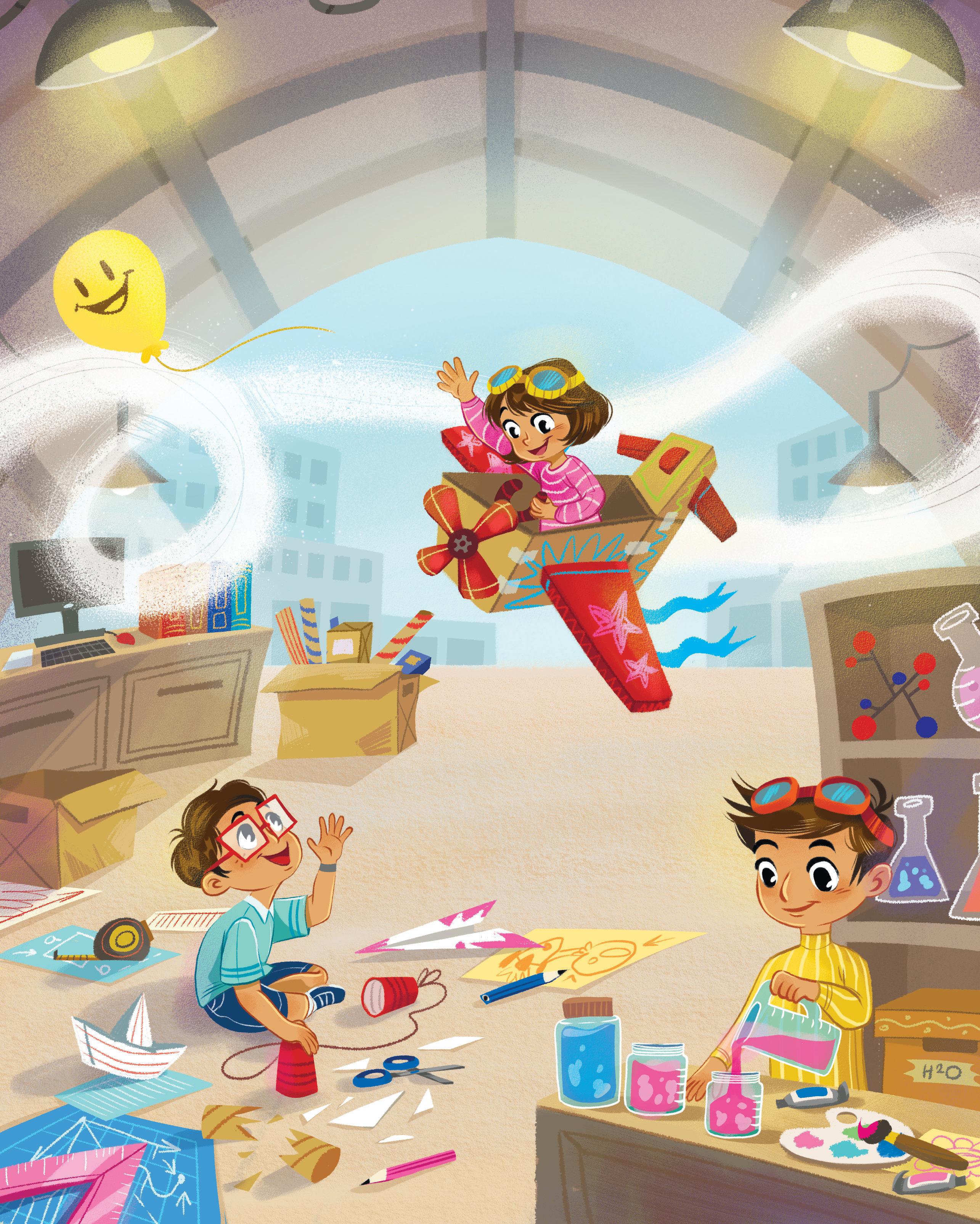


STEM EXPLORATION
Activity Book

Acknowledgements
Academic Authors: Binny Singhal, Diksha Sharma
Design & Production: Satish, Mangal Singh Rana, Wajahat Khan, Sneha Sharma, Vishesh Agarwal
Project Lead: Bhavna Tripathi
VP, Learning: Abhishek Bhatnagar
All products and brand names used in this book are trademarks, registered trademarks or trade names of their respective owners.
© Uolo EdTech Private Limited First edition 2026
This book is sold subject to the condition that it shall not by way of trade or otherwise, be lent, resold, hired out, or otherwise circulated without the publisher’s prior written consent in any form of binding or cover other than that in which it is published and without a similar condition including this condition being imposed on the subsequent purchaser and without limiting the rights under copyright reserved above, no part of this publication may be reproduced, stored in or introduced into a retrieval system, or transmitted in any form or by any means, electronic, mechanical, photocopying, recording or otherwise, without the prior written permission of both the copyright owner and the above-mentioned publisher of this book.
Book Title: STEM Exploration 3
ISBN: 978-93-49697-69-0
Published by Uolo EdTech Private Limited
Corporate Office Address: 91Springboard, 3rd Floor
145, Sector 44, Gurugram, Haryana 122003
CIN: U74999DL2017PTC322986
Printed by: Printpro Solutions
Illustrations and images: www.shutterstock.com, www.stock.adobe.com and www.freepik.com
All suggested use of the internet should be under adult supervision.
Preface
In today’s dynamic world, nurturing curiosity, critical thinking and creativity in learners is essential for preparing them to be the innovators and problem-solvers of tomorrow. STEAM education—integrating Science, Technology, Engineering, Arts and Mathematics—offers a holistic and experiential approach to support this endeavour. By encouraging learners to ask questions, make predictions and experiment, STEAM transforms learning into a joyful process of exploration and discovery while building essential life skills such as problem-solving, analytical thinking and collaboration.
At Uolo, we recognise the transformative potential of STEAM learning. The Uolo STEM Exploration series is based on the vision of the National Education Policy (NEP) 2020 and the National Curriculum Framework (NCF) 2022–23 , reflecting the shift from rote memorisation to experiential, multidisciplinary and competency-based learning. By making learning joyful, discovery-driven and rooted in real-life contexts, the series encourages inquisitiveness, creativity and the spirit of teamwork to enable learners to explore scientific and mathematical concepts in visual and creative ways. Through interdisciplinary connections, the use of accessible materials and a focus on real-world applications, it ensures that the learning remains inclusive, meaningful and lasting.
In line with global perspectives, STEAM is recognised as a pathway to nurture innovation and adaptability while contributing to the United Nations Sustainable Development Goals (SDGs). The STEM Exploration series embraces this global mission, ensuring that learners are prepared to contribute to a sustainable and equitable future.
The STEM Exploration series features age-appropriate, visually engaging and well-structured activities that integrate one or more disciplines of Science, Technology, Engineering, Arts and Mathematics. The book has been thoughtfully designed to spark curiosity and foster inquiry-driven learning through hands-on experiences that connect core concepts with the real world. Each activity inspires learners to observe, test and reflect, giving them the ability to think critically and apply their learning to every day situations.
To further enrich the learning experience, the series comes with digital content, provided free of cost, to ensure a seamless and holistic learning experience for learners. This content is accessible through QR codes, offering live demonstrations of activities for visual and self-paced learning. Together, these components nurture a dynamic learning journey that connects knowledge with skills, preparing children to innovate and thrive.
Uolo is accredited by STEM.org, one of the world’s leading STEM education research and credentialing organisations. This recognition validates the quality, authenticity and impact of our educational offerings. The content has been reviewed and approved by STEM.org’s rigorous standards, underscoring our commitment to delivering globally benchmarked educational resources.
By integrating artistic expression with scientific exploration, the STEM Exploration series nurtures learners to be inquisitive, confident and competent—ready to question, innovate and contribute meaningfully as global citizens.
We extend our warmest wishes to educators, parents and learners as they embark on this journey of discovery and innovation. Together, let us make learning an adventure that sparks imagination and inspires lifelong curiosity.
Key features of the book
Hands-on and Inquiry-Based Learning
The STEM Exploration series sparks curiosity through hands-on, inquiry-led activities that align with the NEP 2020. Children observe, question, explore and solve, thereby, building scientific temper, creativity and problem-solving skills.


STEAM Alignment
The activities in the book integrate Science, Technology, Engineering, Arts and Mathematics, encouraging interdisciplinary connections.
Visually Engaging and Fun
The book features vivid colours and lively illustrations to engage learners. A real-life image is provided at the end of each activity, helping learners connect concepts with practical outcomes.
Easy-to-Access Resources

All experiments are safe, age-appropriate and use low-cost and easily available materials, with clear step-by-step instructions for easy execution.

Critical and Creative Thinking
The activities encourage ‘learning by doing’. The Science Behind It section includes simplified explanations of the underlying principle while the Find Out More section offers extension activities for deeper exploration.

Real-World Connections
Experiments and worksheets connect learning to daily life and local contexts, making it practical and meaningful. The Real-Life Connect highlights direct applications of the concepts, showing learners how classroom concepts are relevant in the world around them.

Digitally Powered and Application-Based
Each activity is followed by a fun, application-based worksheet that helps learners revise and reinforce the key concepts. QR codes provide experiment videos for better clarity and self-paced learning.

Framework
Each activity in this book is thoughtfully designed to integrate the domains of STEAM — Science, Technology, Engineering, Arts and Mathematics. The table illustrates how activities align with one or more STEAM areas, ensuring that learning is interdisciplinary, engaging and competency-driven, in line with the NEP 2020 and NCF 2022 –23.
Smart ScIentIfIc TIps Before You ExperIment







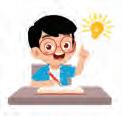
Gather Your Materials First
Before you begin, collect everything you need for the experiment. Having your materials ready saves time and keeps the process smooth.
Ask Questions Often
Good scientists are curious. Don’t just follow the steps stop and ask ‘Why did this happen?’ or ‘How does this work?’ The more questions you ask, the deeper your understanding will be.
Take Your Questions Further
Use each experiment as a starting point. If something surprises you, try it again with a change. New questions lead to new experiments, and that’s how real discoveries happen!
Failure Is Part of Science
Not every experiment works the first time, and that’s okay. Instead of feeling discouraged, think about what might have gone wrong and what you can adjust. Failure often teaches you more than success.
Make a Journal
Maintain a journal for all your experiments. Record observations, results, sketches and reflections. Journalling helps organise your thoughts, track progress over time and sparks ideas for future experiments.
Have Fun and Stay Curious
Science and experimentation is all about enjoying the process of discovery. Even small results can be exciting if you pay attention. Look for the ‘Aha!’ moments and celebrate them.




DancIng raIsIns
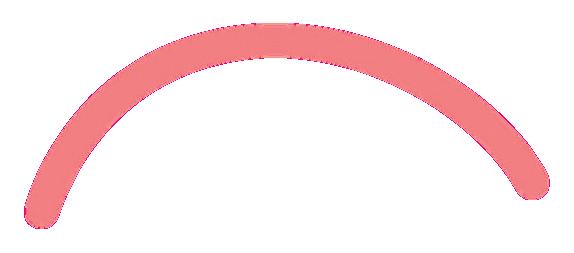
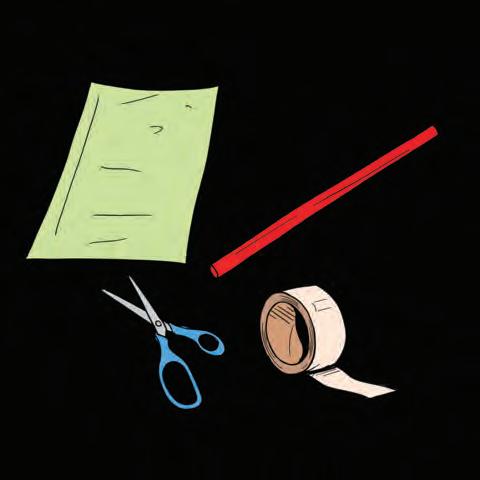
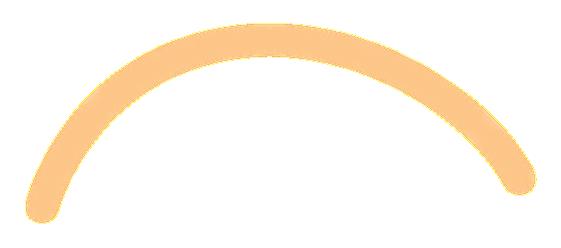

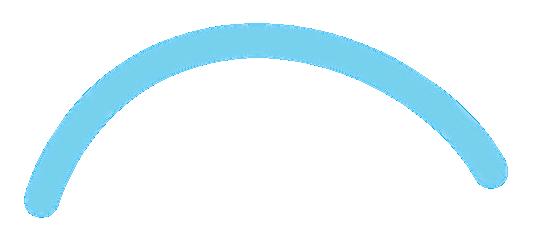
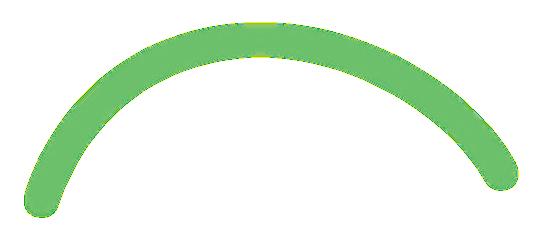
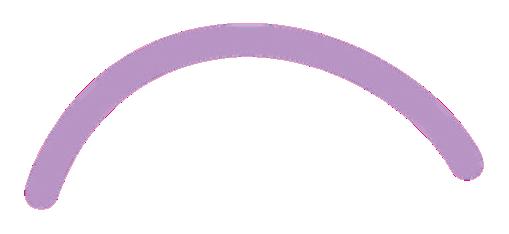




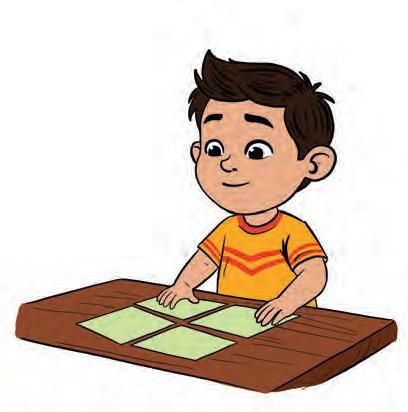


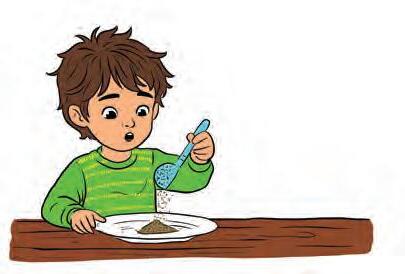
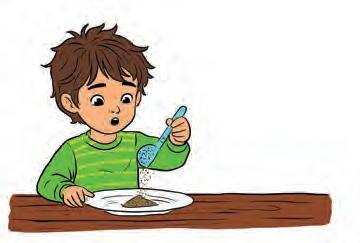
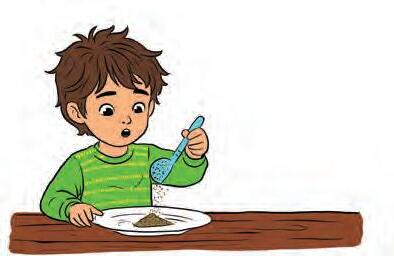

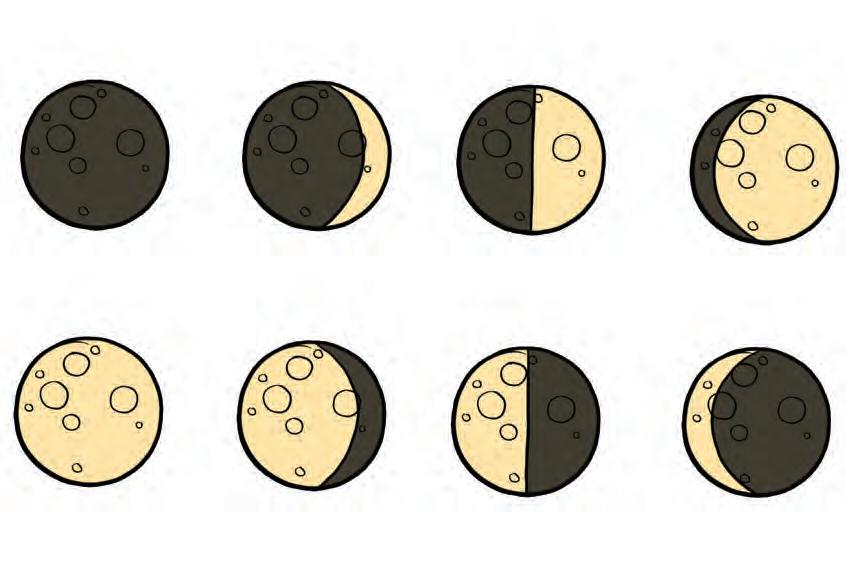
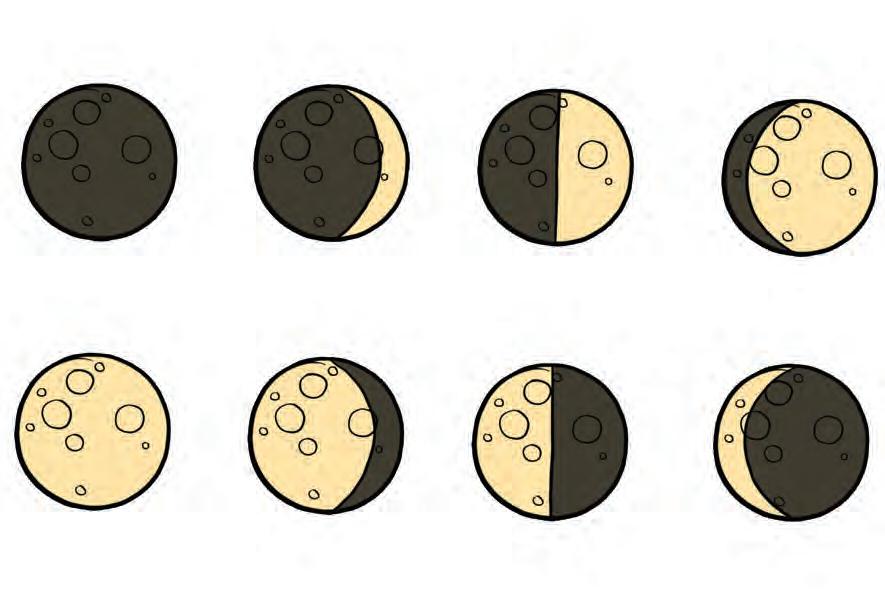



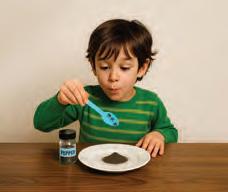

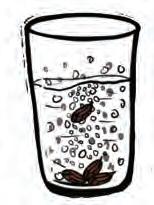
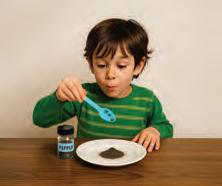
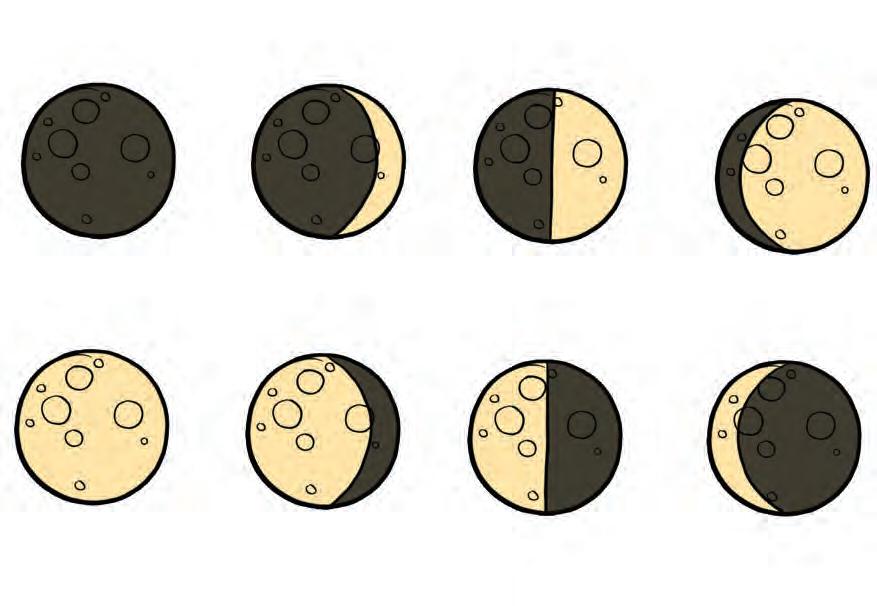


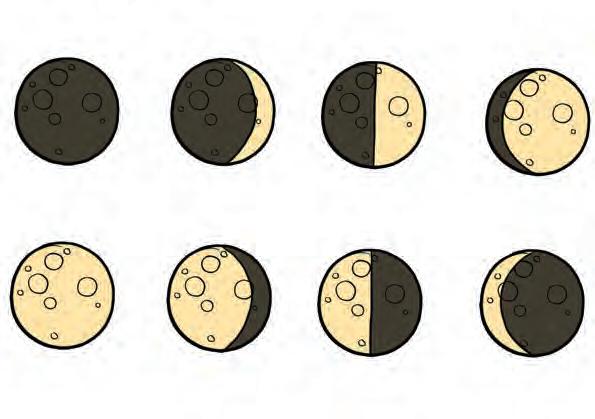








DancIng raIsIns
In this activity, we will see how soda bubbles make raisins move up and down, as if they are dancing.
• 3–5 raisins What We Need Let’s Begin
• 1 glass
• 1 bottle of soda
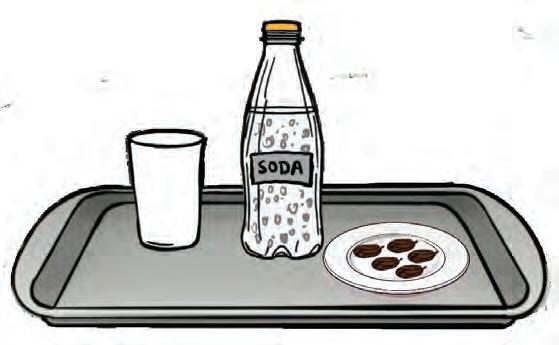


1. Take a glass and fill it with soda water.
Watch out
Do not shake the bottle before opening it, or the soda may fizz up and spill.
2. Gently drop 3 into the glass of soda.
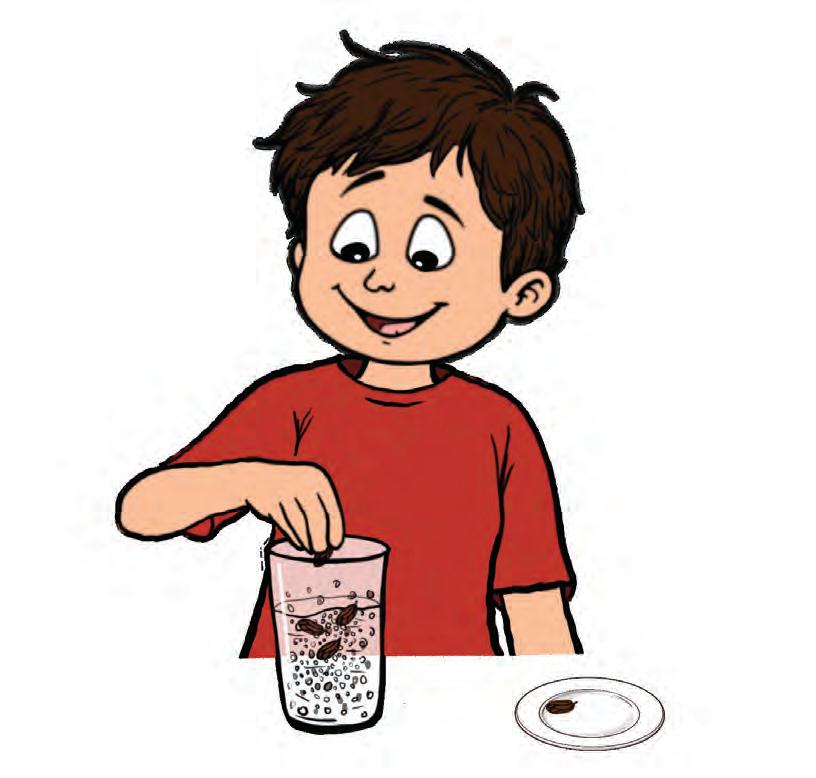
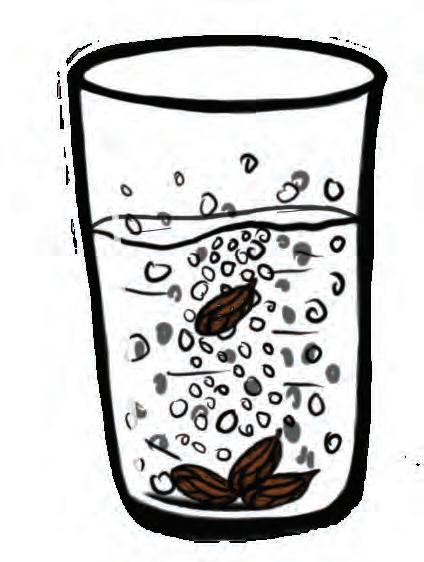
3. Look closely, the raisins will sink at first and then the bubbles will stick to them.

In washing machines, bubbles help lift away dirt and clean clothes.

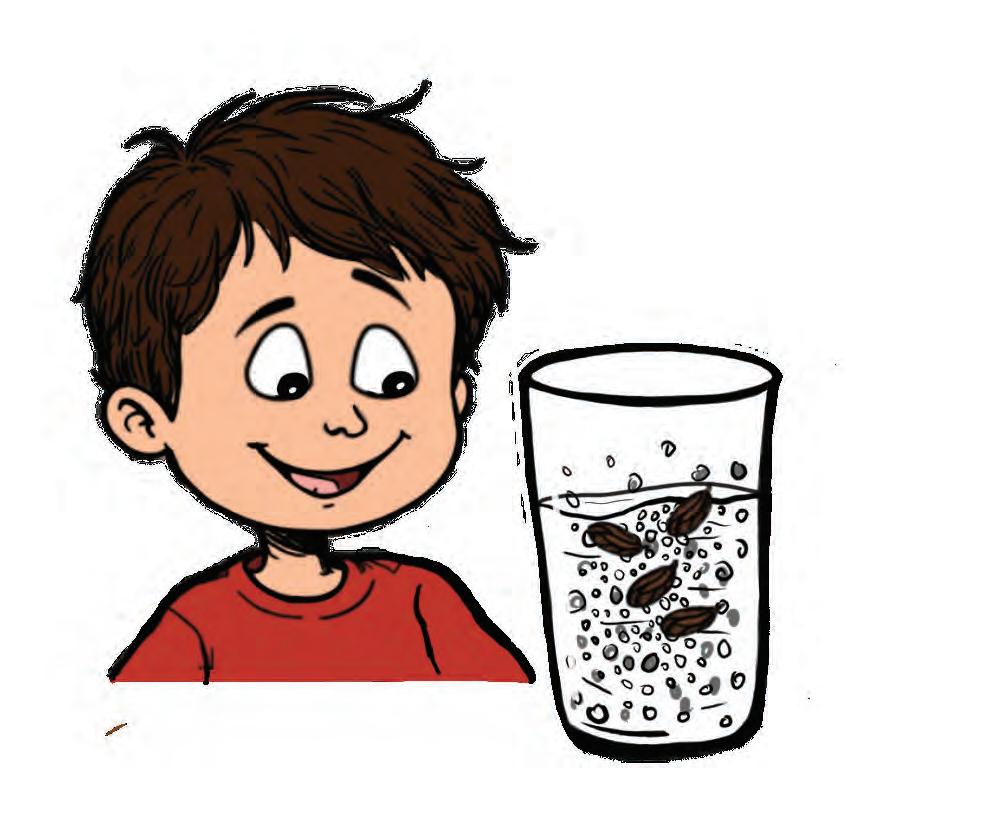
Wait and watch the raisins move up and down in the soda as if they are dancing.
Activity in Action
SCIENCE BEHIND It...
Soda contains tiny bubbles of gas. When you drop raisins into the soda, the bubbles stick to them and help them float to the top. When the bubbles pop at the top, the raisins sink again.
Find Out More!
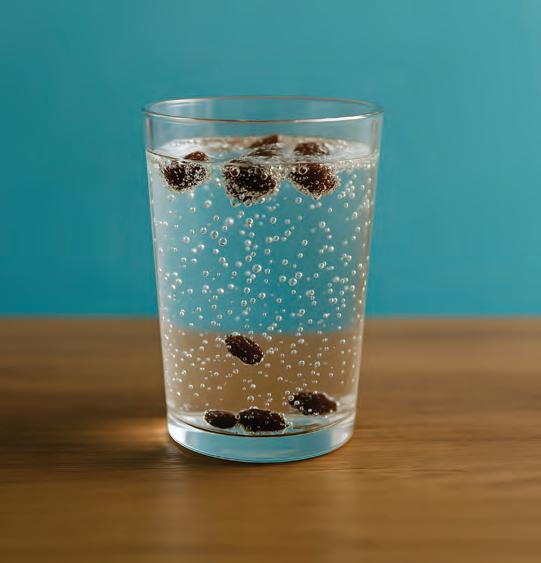
Drop peanuts or grapes into soda water. See if they dance like raisins or stay at the bottom.
Check your learnIng!
1. Think and write.
I float in the air, shiny and round. I pop when you touch me what am I?
2.
Tick ( ) the correct answer.
A. Why do rice grains move up and down while boiling?
(a) The rice grains jump on their own.
(b) Gas bubbles lift the rice grains.
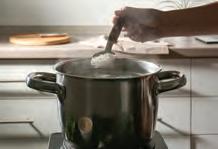
B. When you pour soda into a glass, you see bubbles rising to the top. What do these bubbles show?
(a) The soda has sugar inside it.
(b) The soda has gas inside it.
3.
Fill in the blanks.
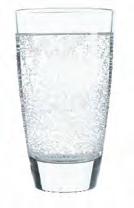
(a) A life jacket has (air/water) inside that helps it stay afloat on water.
(b) Bubbles from the soda stick to the raisins and make them (rise/disappear).
(c) When you (open/close) a cold drink bottle, tiny bubbles of gas rush out with a fizz.
(d) So da bubbles rise to the top because gas is (lighter/heavier) than liquid.

FruIt Boats
In this activity, we will test different kinds of fruit to see if they float or sink in water.

What We Need
• A coloured sheet
• A knife
• A large bowl
• Water
• Gluestick
• Toothpicks

Why
• Fruit: An apple, an orange
Let’s Begin
1. Cut each fruit in half. Leave the peel on one half and remove it from the other with an adult’s help.
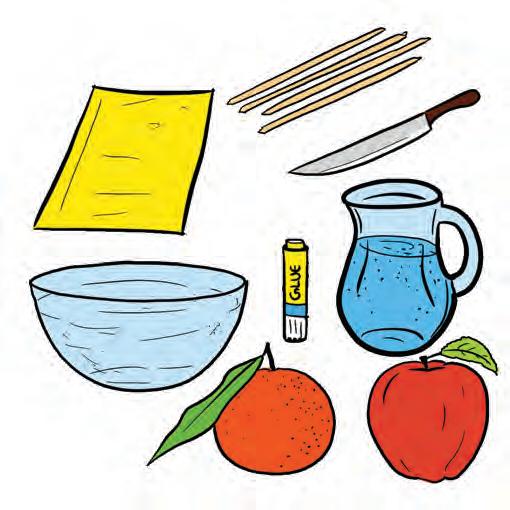

2. Cut a small triangle from the coloured sheet and stick it to a toothpick to make a tiny sail.

3. Gently stick the sail into the soft part of each fruit half.
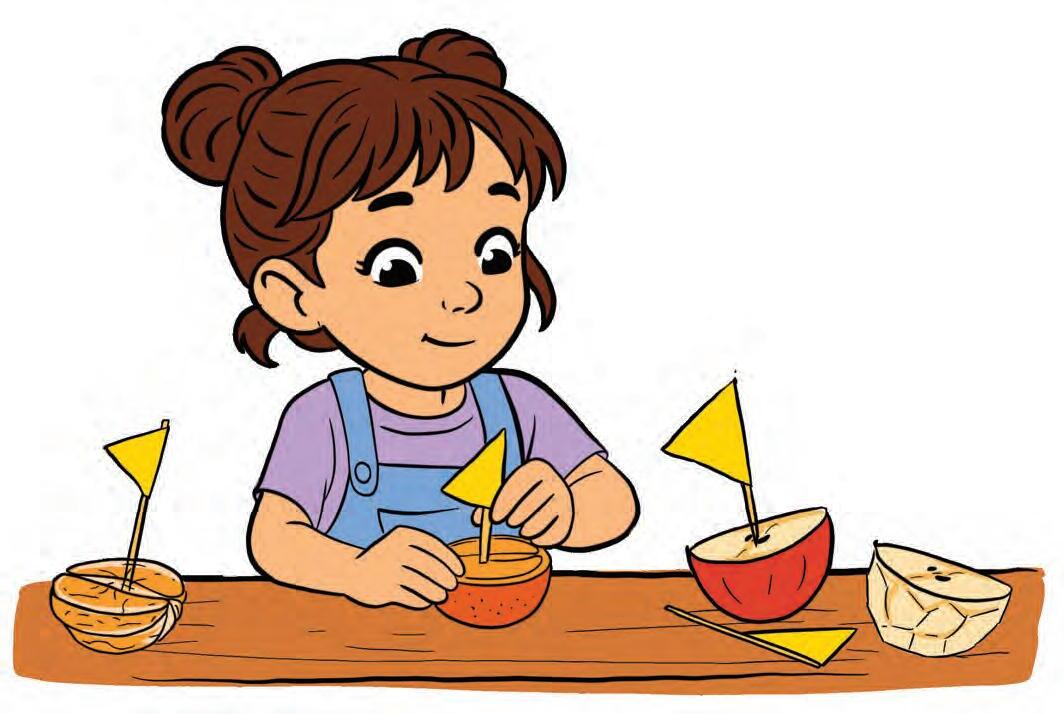
REAL-LIFE CONNECT
Life jackets help people float in water because they are made of materials that hold air. This prevents a person from sinking.


4. Place all the fruit boats into a bowl of water. Watch which ones float and which ones sink.
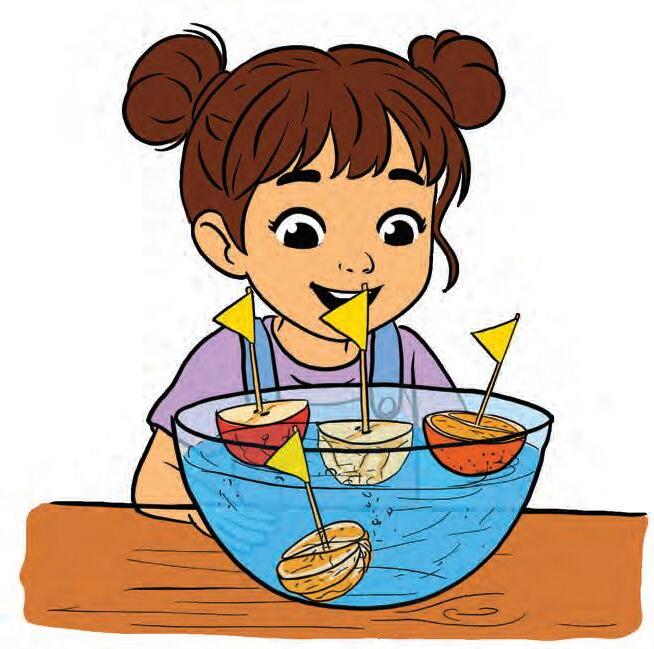
Activity in Action
SCIENCE BEHIND It...
An apple floats because it has air spaces all over, making it lighter than water. An orange floats only with its peel on, as the peel traps air and makes it spongy. Without the peel, the orange sinks because it has no air spaces and becomes heavier.

CHECK YOUR LEARNING!
1.
Tick ( ) the correct answer.
Why does the watermelon shown in the picture float in water, even though it looks so big and heavy?
A. Because it is soft and round.
B. Because it has air trapped inside.

2.
Based on what you saw in the activity, colour the correct box.
(a) Apple with peel
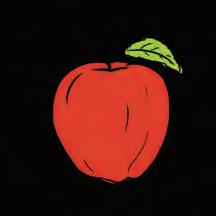
(b) Apple without peel
FLOATS SINKS FLOATS SINKS
(c) Orange with peel
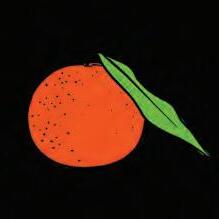

(d) Orange without peel
FLOATS SINKS FLOATS SINKS
Tick ( ) True/False. 3.

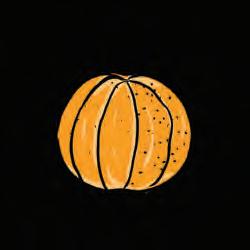
Grapes sink in water because they have no air spaces and are heavier than water.

Paper Rocket
In this activity, we will make a paper rocket and launch it by blowing through a straw.

What We Need
A coloured paper/sheet
A pair of scissors

Let’s Begin
A straw Tape 1.
Fold a paper twice, then cut along the lines to get four rectangles.
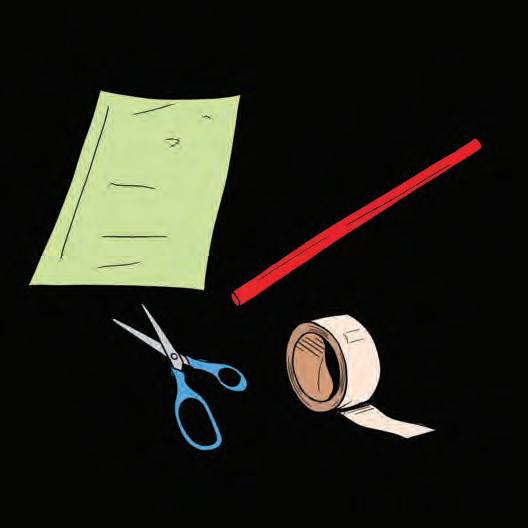

2.
3.
Roll a rectangle around a straw and tape the edge to make a tube.
Take the tube off the straw, pinch one end and tape it to make the rocket body.
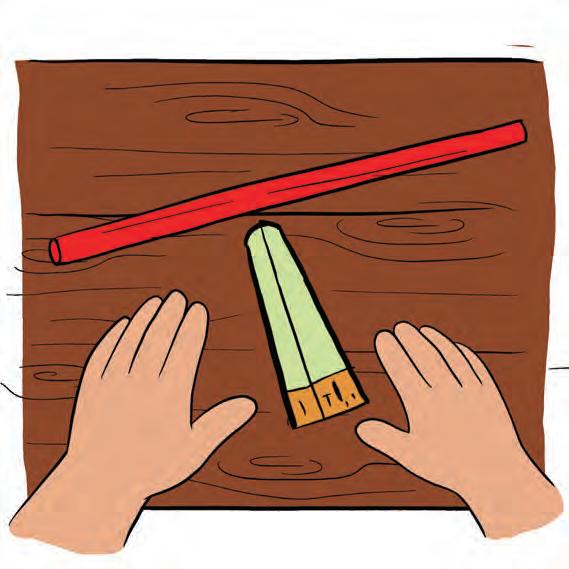


Make triangular fins from paper and tape them near the bottom of the rocket. 4.
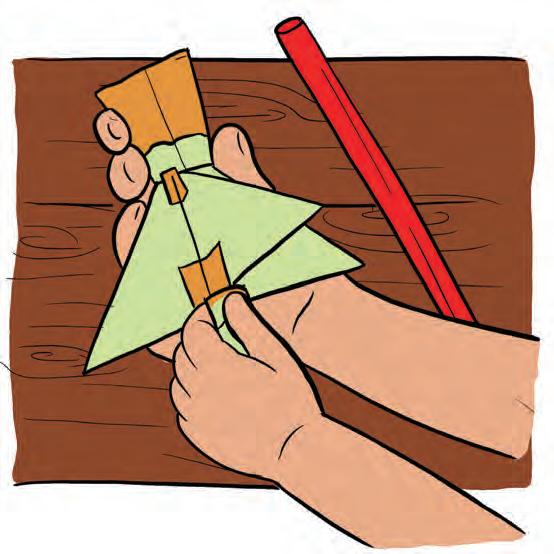
5.
Place the open end of the rocket onto the straw.

Blow into the straw to make your rocket fly. Measure the distance it travels.
Do not aim the rocket at anyone’s face or eyes. Watch out

Activity in Action
ScIence BehInd It...
When you blow into the straw, the rocket flies because the moving air gives it a strong push. The fins help the rocket fly straight without turning or falling.
Find Out More!

Blow air softly and then strongly into your rocket. See which one goes the farthest.
Check your learnIng!
1. Tick ( ) the correct answer.
A. What makes the rocket fly?
Pulling it with a string
Blowing air through a straw (a) (b) (a) (b)

B. Why do we add fins to the rocket?
To make it heavy
To help it fly straight
2. Fill in the blanks.
A. B. C.

We use a ______ (straw/stick) to blow and launch the rocket. The ______ (harder/softer) we blow, the farther the rocket will go.
The rocket moves forward because of the ______ (air/water) we blow into it.
3. Trace and colour in the picture.


StrIng Telephone

• A sharp pencil S Sound travels through vibrations T Using cups and string as communication tools E Making a string telephone
In this activity, we will make a string telephone to learn how sound travels.
What We Need
• 2 paper cups
• A long piece of string (thread or wool)

Let’s Begin
1. Take two paper cups and make a small hole at the bottom of each one.

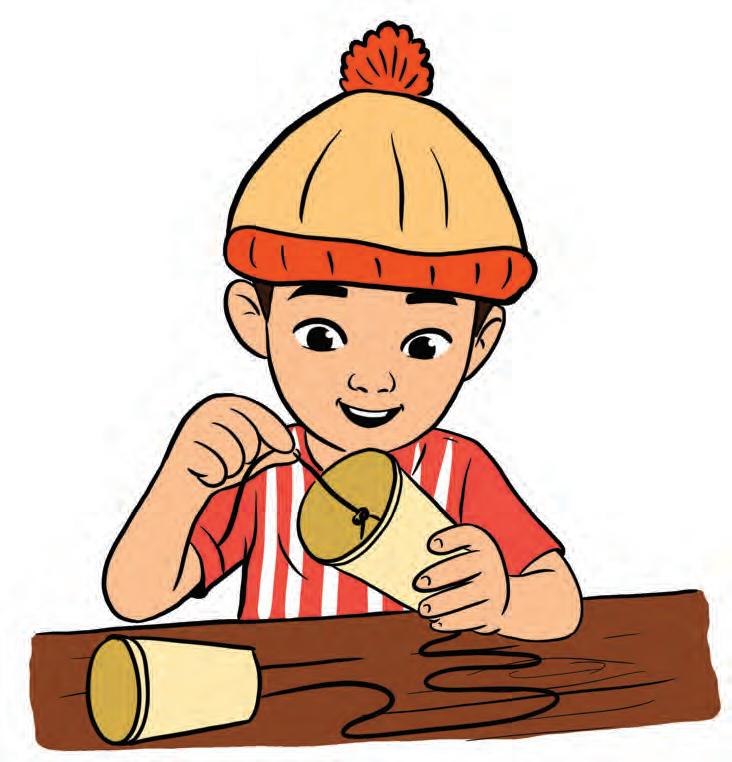
2. Push one end of the string into one cup and the other end into the second cup. Tie a knot inside each cup to hold the string in place.

DId You Know?

Instruments such as guitars and sitars create sound when their strings move back and forth (vibrate).

3. Hold one cup and give the other one to your friend. Move far apart until the string is straight and tight.

Make sure the string is tight, loose strings will not carry sound well. Watch out

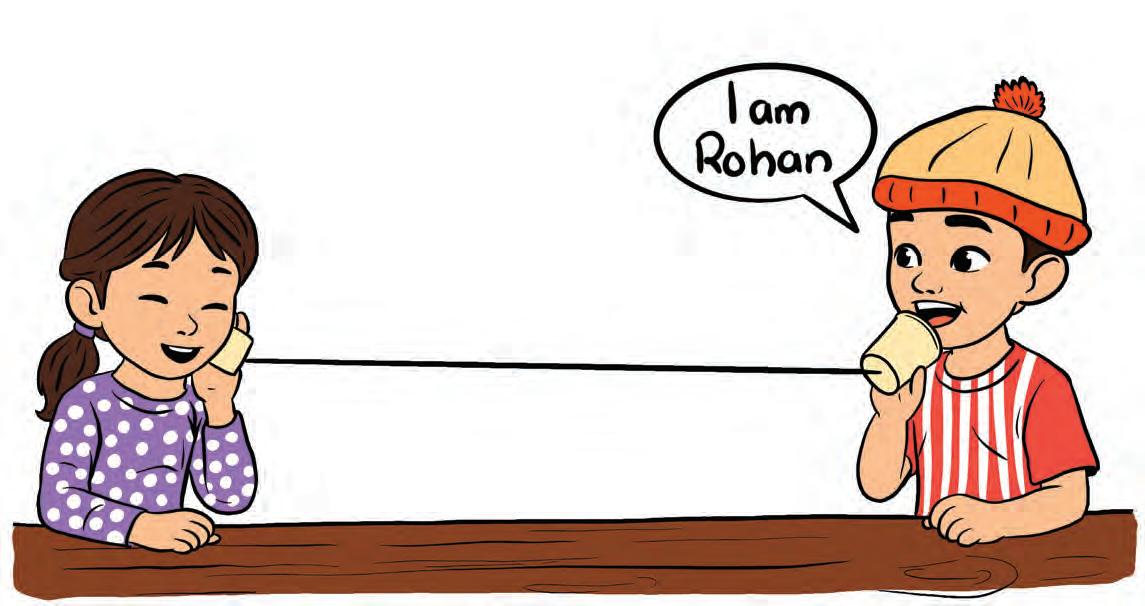
SCIENCE BEHIND It...
When you speak into a cup, your voice creates vibrations. These vibrations travel along the tight string to the other cup. The other cup vibrates too and your friend can hear your voice.
4. One child speaks into the cup and the other one listens Find Out More!

Compare short, medium and long strings. Observe which length carries sound the clearest.
A.
The strings stop vibrating. Check your
learnIng!
1. In each pair, colour the box for the action that happens first.
2.
B. C. You play the violin. You hear a sound.
The strings vibrate.
The sound disappears. The strings vibrate.
Riya and her friend made a string telephone, but they could not hear the sound clearly. What could be the reason?
(a) The string was too loose.
(b) The string was very shiny.
(c) They spoke very loudly.
3. State T for True or F for False.
(a) Sound can travel through solids like a string.
(b) A loose string carries sound better than a tight string.
(c) A longer string may affect how clear the sound is.
(d) Str ing instruments produce sound when their strings vibrate.

RIsIng RaJma BEANS
In this activity, we will learn how materials of different sizes behave when we mix them together.
What We Need
A jar or bottle
Let’s Begin

2 small cups of sugar 2 small cups of kidney beans (Rajma) Take a jar and fill it with kidney beans. 1.

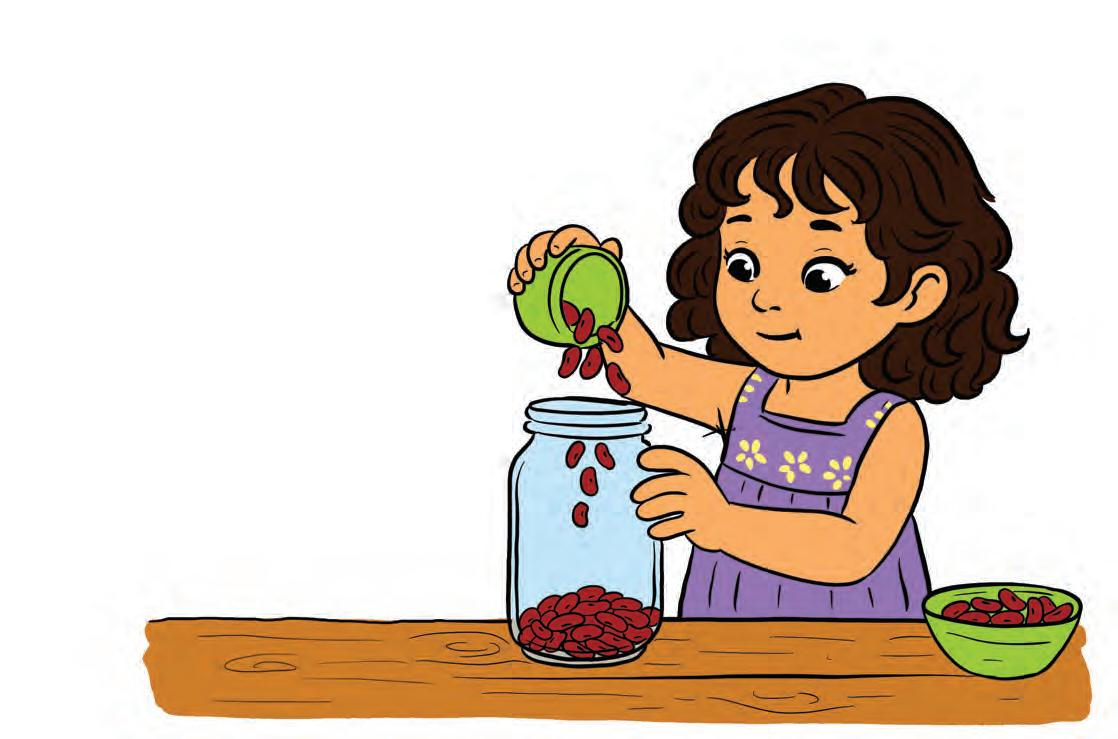
Now, add sugar to it.
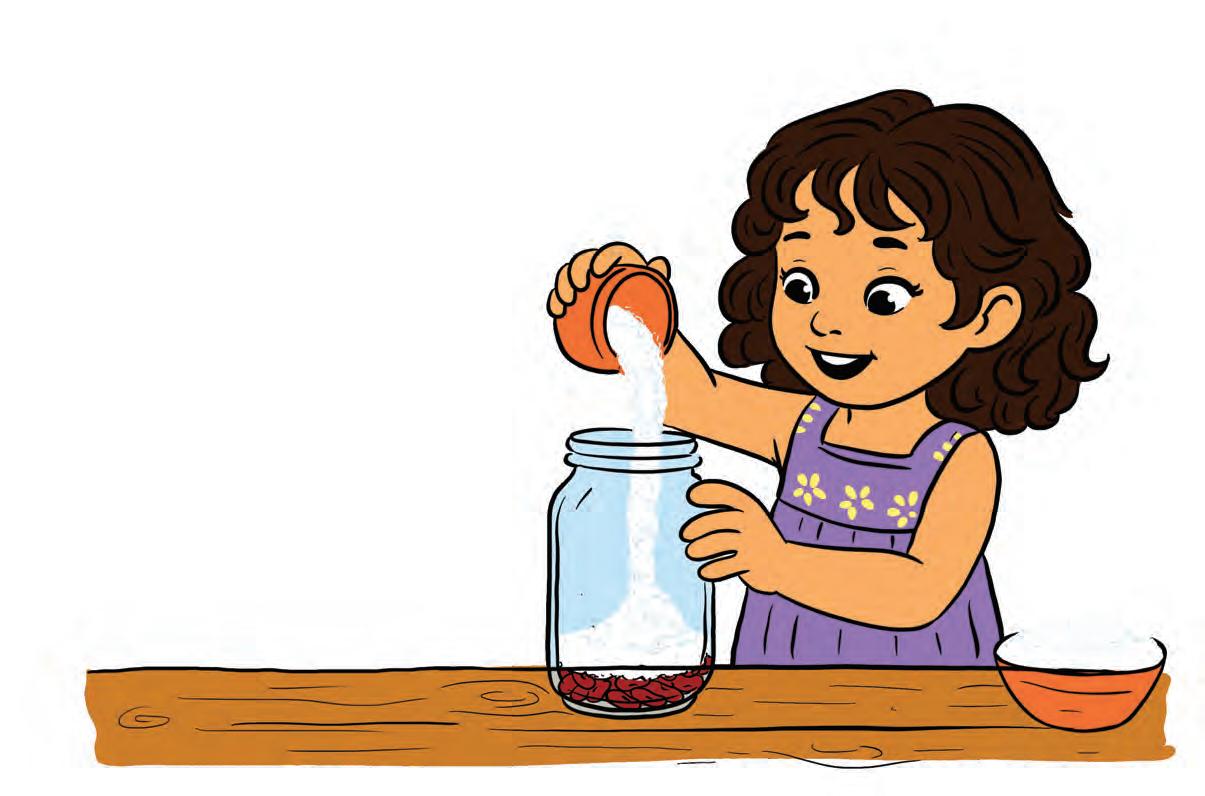

Close the jar and tap it gently on a surface.
Make sure the lid is closed tightly before tapping. Watch out

Watch the kidney beans rise to the top while the sugar settles at the bottom. 4.

Activity in Action
ScIence BehInd It...
When you shake the jar, the small sugar grains move down through the tiny gaps between the larger rajma beans and settle at the bottom. This makes the bigger rajma beans slowly rise to the top.

Find Out More!
Shake the bottle with only the rajma beans, then with sugar, and then with both. Does the sound change?
Check your learnIng!
1. Tick ( ) the correct answer.
A.
The tiny crumbs fall through the gaps between the bigger biscuits and settles down. (a) (b) (c)
The crumbs are sticky and stick to the bottom.
The crumbs are bigger and heavier and settle at the bottom.
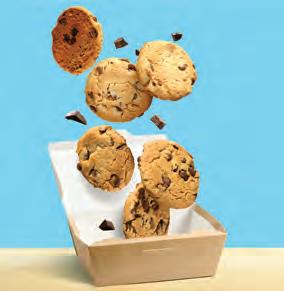
B. Which of these pairs would behave in a similar way to rajma and sugar when shaken in a bottle?
Water and oil (a) (b) (c)
Paper and cotton
Pebbles and sand
2. Fill in the blanks.
A. Rohan opened a biscuit box and saw lots of tiny crumbs at the bottom. He wondered, 'Why do all the crumbs go down?' What do you think is the reason?
When we shake a mixture, (smaller/bigger) objects often move to the bottom.
B. C. D.
In the rajma and sugar experiment, the (rajma/sugar) rises to the top.
The sugar moves down because it can slip through (small/large) gaps.
The (size/colour) of particles affects how they move in a mixture.


Balloon Monster
In this activity, we will observe how a balloon inflates all by itself.
What We Need
• 1 balloon
• 1 spoon
• 1 marker
• 1 cup vinegar
• 1 bottle
• 1 tablespoon of baking soda
• 1 paper
Let’s Begin


Draw a monster face on the balloon using a permanent marker.
2. Roll a piece of paper into a cone shape.

3. Place the paper cone in the mouth of the balloon. Add 1 tablespoon of baking soda in it.
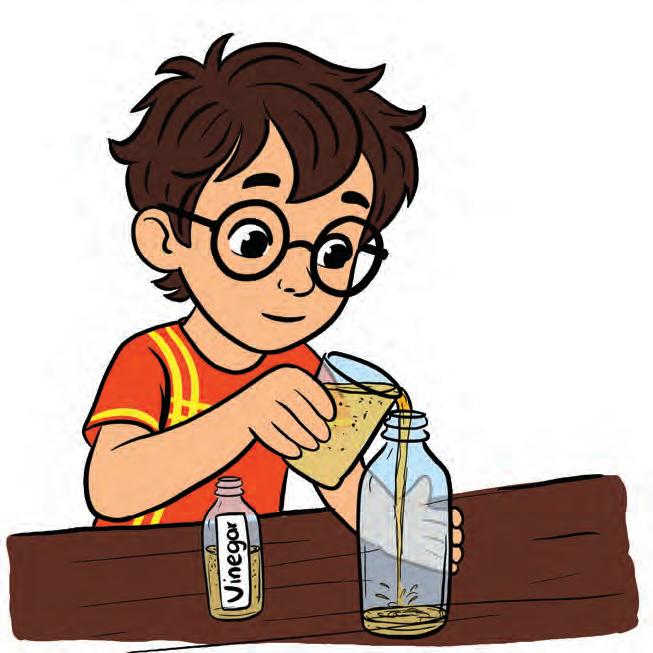
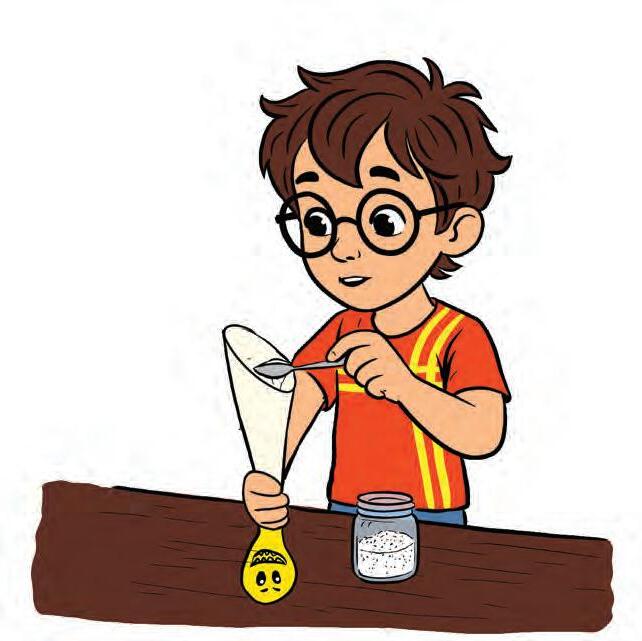
Pour 1 cup of vinegar into the bottle.
5. Stretch the mouth of the balloon over the top of the bottle, but do not let the baking soda fall in yet.
Watch out Keep the bottle and balloon away from your face and eyes.


6. Now lift the balloon up so the baking soda falls into the vinegar. Watch your monster balloon inflate. Find Out More!

SCIENCE BEHIND It...
When baking soda mixes with vinegar, it makes a gas. This gas fills the balloon and inflates it.
Activity in Action
Add a little hot water to the vinegar and see how it changes the way the balloon blows up.
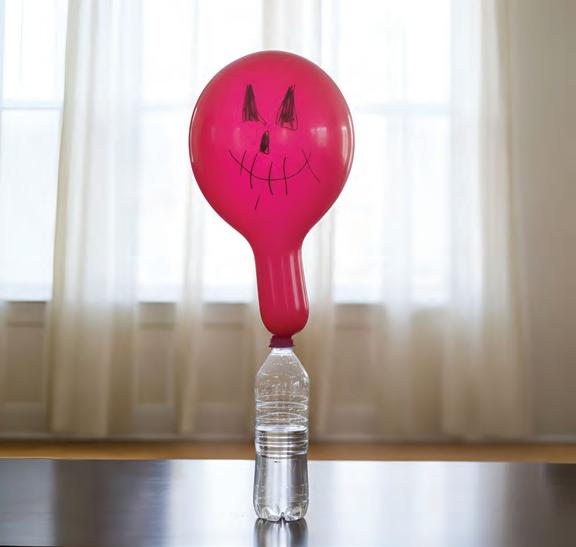
1. Tick ( ) the correct answer.
A. It is Riya’s birthday and her mother is baking a cake for her. She adds baking powder to the cake batter.
(a) Why does she add the baking powder?
i. To make the cake sweet
ii. To make the cake soft and fluffy
iii. To keep the cake fresh

(a) Riya sees that her cake has tiny holes inside after baking. What made those tiny holes?
i. Gas bubbles made by baking powder
ii. Water bubbles made by baking powder
B. Our balloon monster filled up because of gas. Which of these things also use gas to work?
(a) Football (b) Car tire
(c) Swimming tube (d) All of the above
2.
Which balloon will fill up the fastest? Number the bottles from 1 (fastest) to 3 (slowest), based on the temperature of the vinegar.




Tornado In a bottle
In this experiment, we will learn how water can spin to form a tornado in a bottle.
• A bottle
• Water

• Glitter What We Need
Let’s Begin S Water moves in a spinning motion
1. Take a bottle and fill it halfway with water.
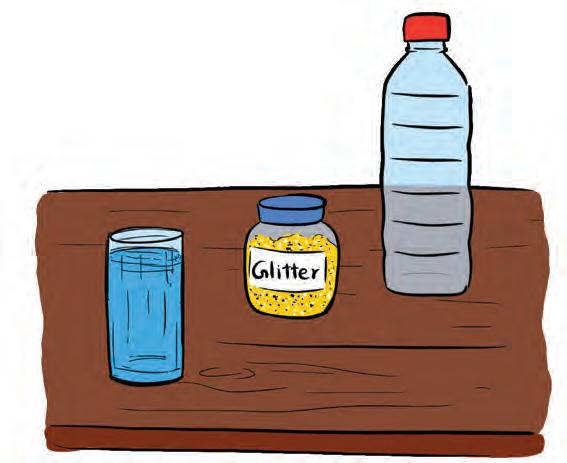
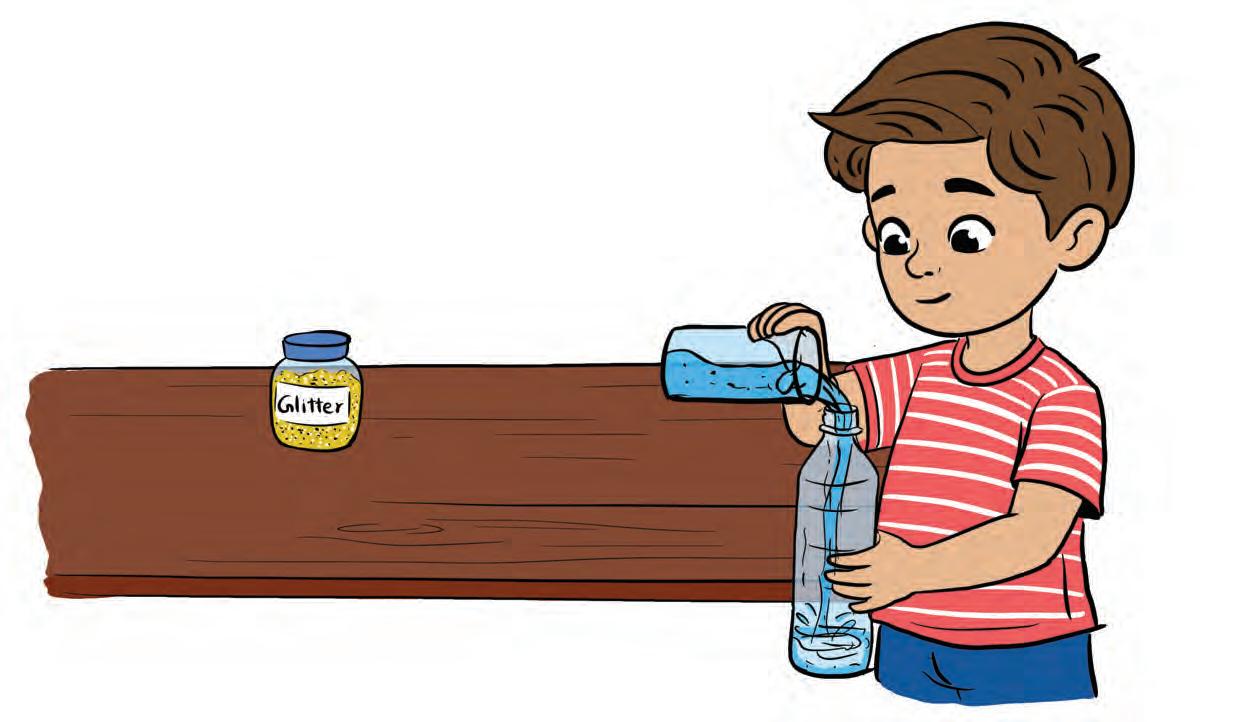
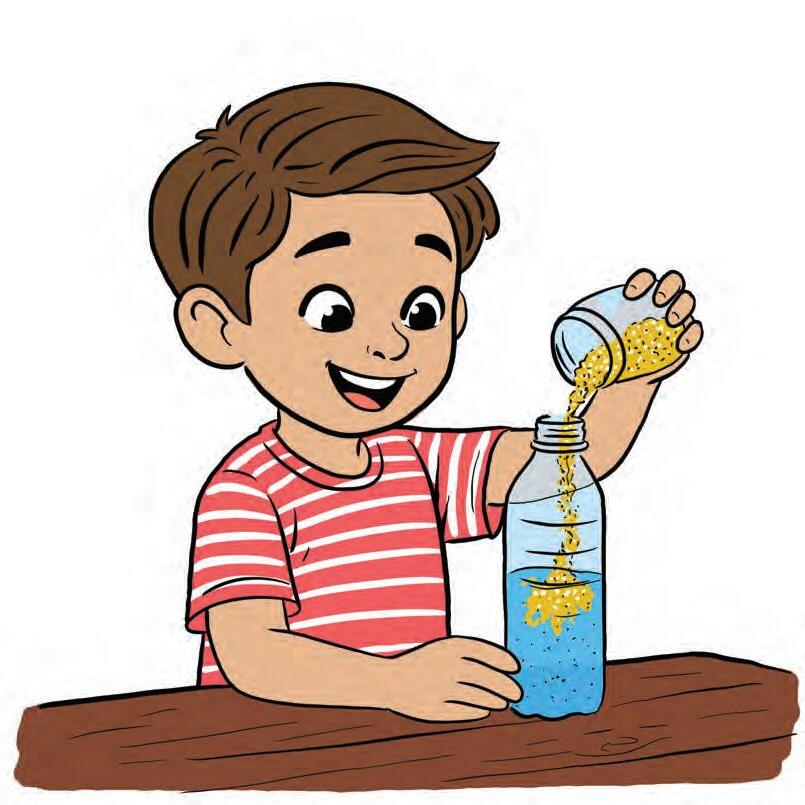
2. Add some glitter to the water and close the bottle.
3. Hold the bottle in the middle with one hand and swirl it quickly in circles.

DId You Know?

A tornado is made of spinning air that is in contact with both the earth’s surface and the clouds.

Watch out Close the cap tightly to avoid spills.
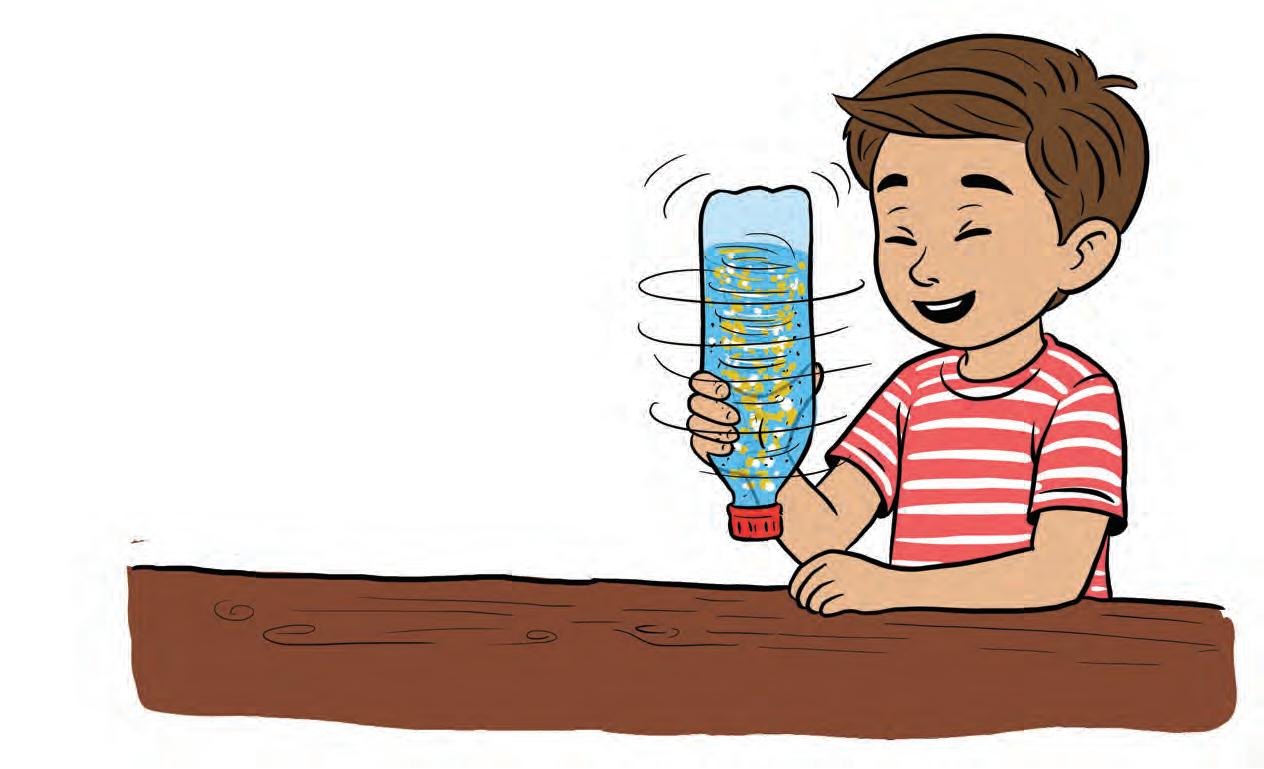

4. Watch the water spin and form a mini tornado inside the bottle.

Activity in Action
SCIENCE BEHIND It...
When you swirl the bottle, the water spins fast at the sides and slower in the centre. This makes a funnel shape, like a tornado. The air moves up through the centre and makes the tornado easier to see.
Find Out More!
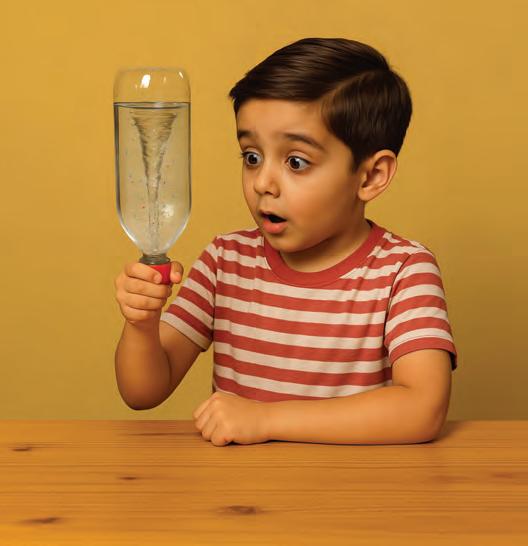
Try using watercolour instead of glitter. Does it make the tornado look brighter and easier to see?
1. Label the types of motion.
Up and down Ro und and
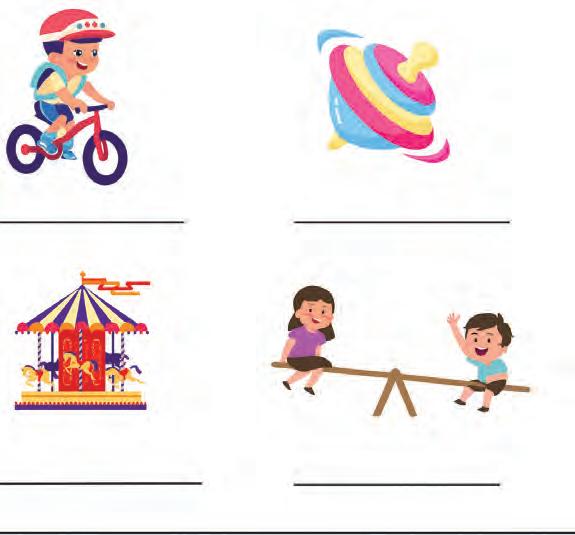

2. Write T for True and F for False.
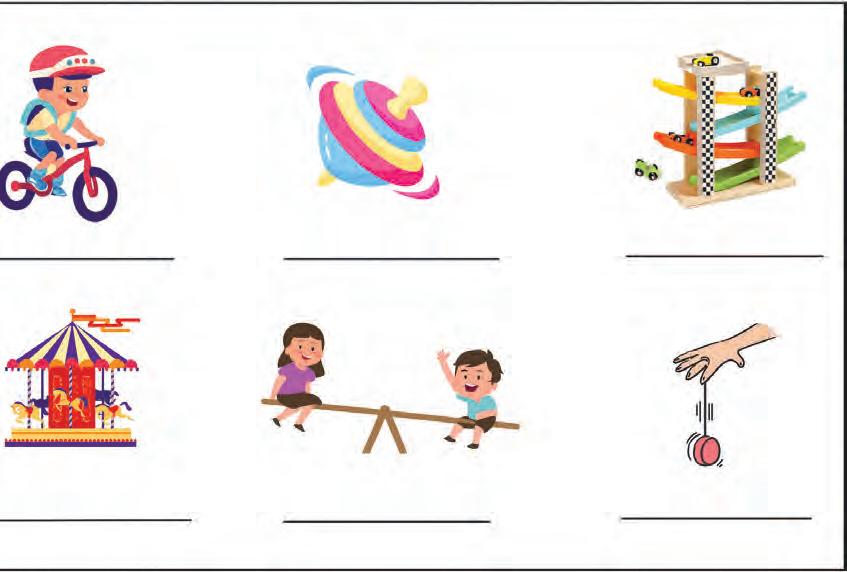
(a) A tornado in a bottle forms only when the bottle is fully filled with water.
(b) The swirling water forms a funnel shape in the centre.
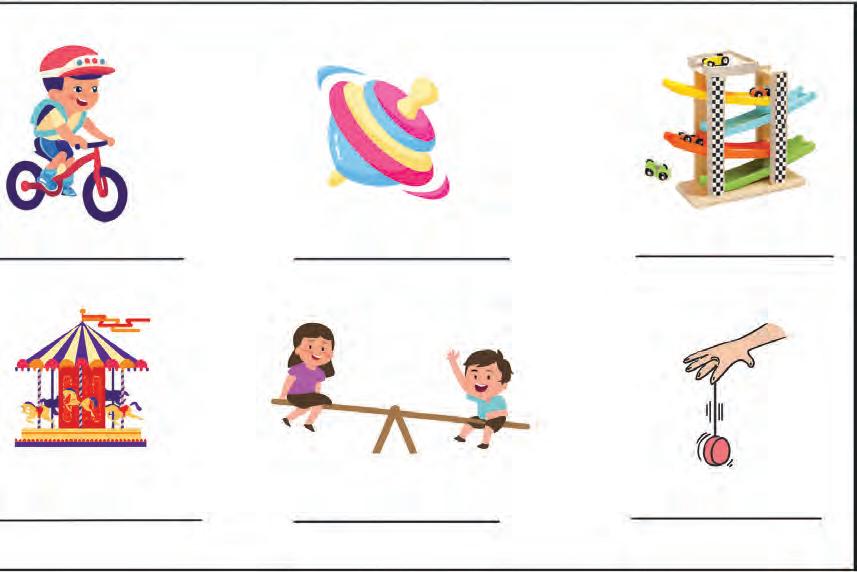
(c) Glitter is necessary to create the tornado.
3. Fill in the blanks.
(c) A funnel shape is formed because moves into the centre of the swirl. Check
centre si des swirl air
(a) Water spins quickly at the and slowly at the of the bottle.
(b) A tornado in a bottle is created when we the bottle in circles.

RaIsed-Salt PaIntIng
In this activity, we will see how salt, glue and colours work together to create a beautiful raised-salt painting.
What We Need


• A drawing sheet
• A pencil
• A tray
• A paintbrush
• Watercolours
• Glue
• Salt
• Water
• Small cups or bowls
1. Draw a flower on the drawing sheet using a pencil.
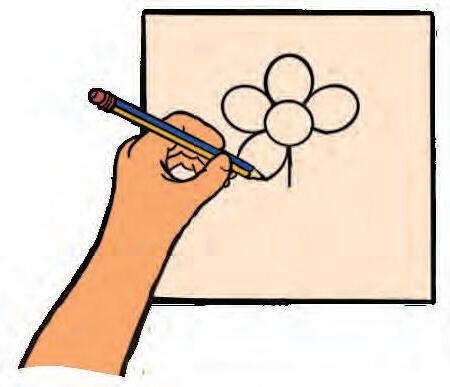

2. Place the sheet on a tray. Carefully trace the pencil lines with white glue.
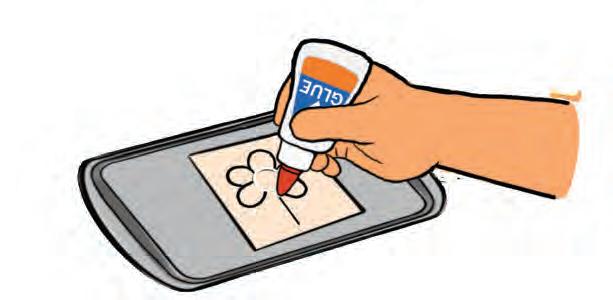
3. While the glue is still wet, sprinkle salt over the glue lines.
4. Gently shake off the extra salt onto the tray.
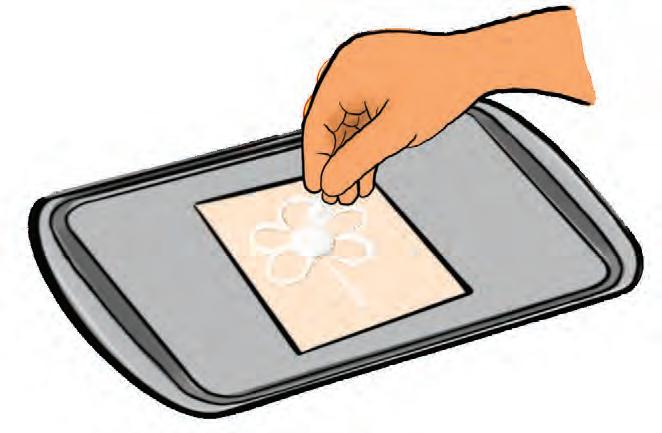
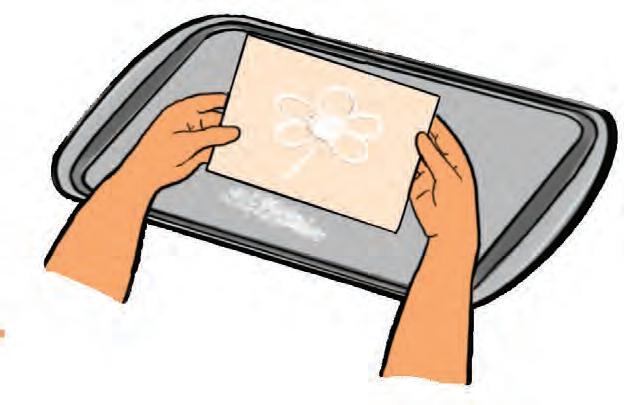
5. Mix your chosen watercolour shades with a little water in cups or a palette.
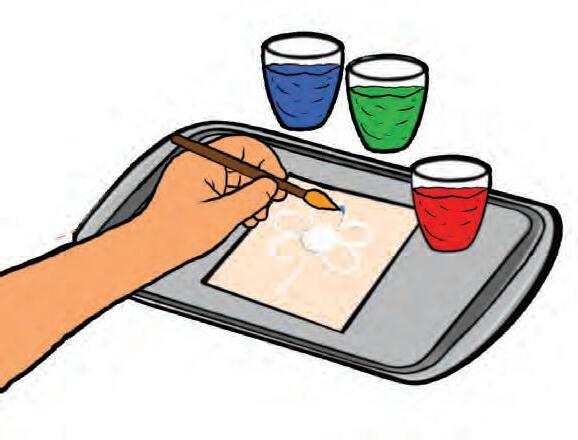

6. Use a paintbrush to gently touch the salted glue lines with coloured water. Watch the colours spread along the design.


SCIENCE BEHIND It...
Salt soaks up the water. When you drop coloured water on the salted glue lines, the salt pulls in the water and spreads the colour, creating a beautiful raised work of art.
Find Out More!
Watch out
Do not let the salt get too wet — it can make the colours mix.
Keep your painting in a safe place and let it dry fully.
Activity in Action

Add a little glitter to the salt before sprinkling it to make your painting sparkle.
Check your learnIng!
1. Tick ( ) the correct answer.
A. Riya is excited about making a raised salt painting. Help her by answering the questions.
(a) Riya has drawn a flower with a pencil. What should she do next?
i. Start painting with colours
ii. Trace the lines with glue
iii. Sprinkle glitter on the drawing
(b) The glue lines are ready. What should Riya sprinkle on the glue?






i. Salt






ii. Sugar
iii. Sand
(c) Now, Riya wants to add colours to her salted design. Which tool should she use?

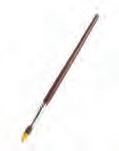
ii. Paintbrush i. Spoon
iii. A pair of
scissors
(d) Oo ps! Riya added too much coloured water and the colours are spilling. What should she remember next time?
i. Use more coloured water
ii. Use less coloured water
iii. Not to use coloured water


AIr keeps It dry
In this fun activity, we will see how air can protect a little paper boat and keep it safe from water.

• A glass
• A bowl of water
• A piece of paper What We Need
Let’s Begin
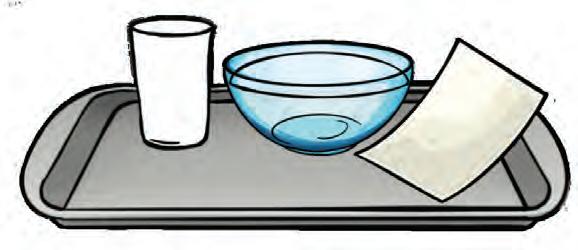
1. Take a small piece of paper and fold it into a boat.
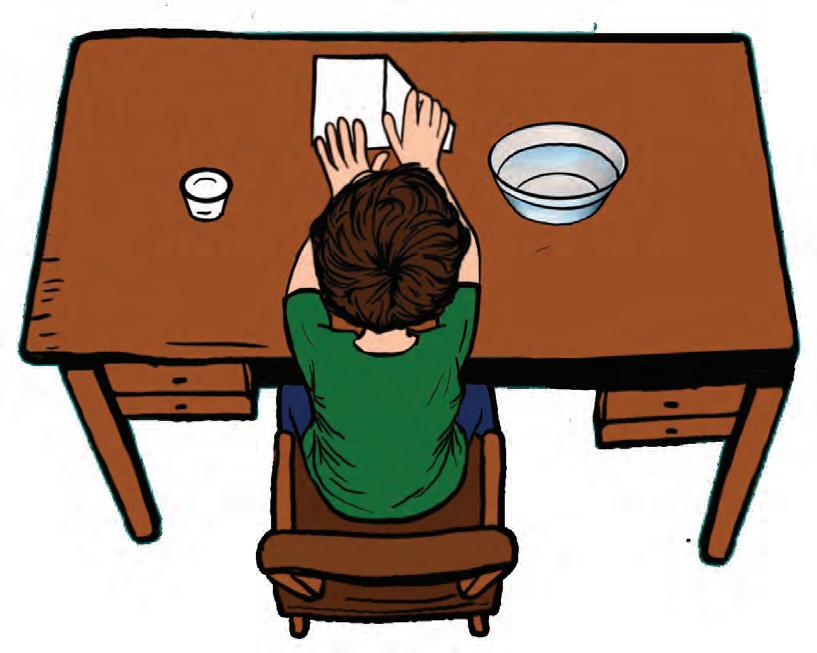
2. Place your paper boat gently in the bowl of water and let it float.

4. Look inside the glass, the little boat is dry even under the water.
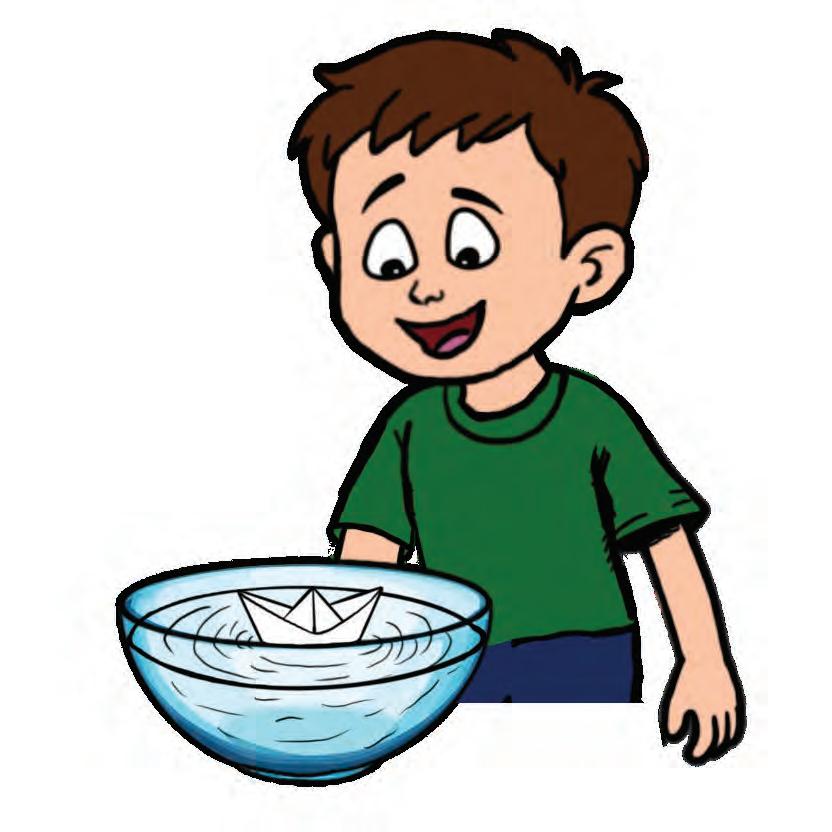
3. Hold an empty glass upside down over the boat and push it straight down without tilting it.


5. Now lift the glass up slowly, take out the boat and feel it. Is it still dry?
Watch out
Be careful. If you tilt the glass, the boat will get wet.
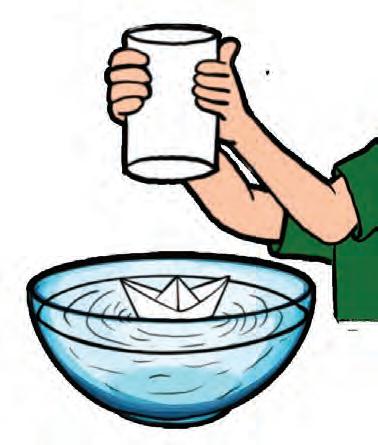
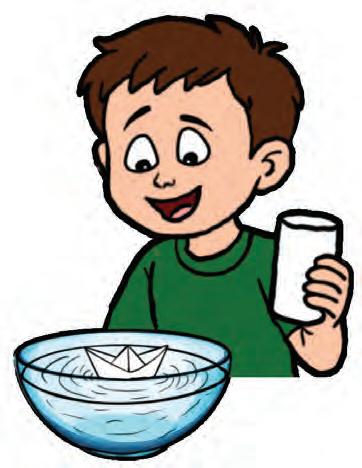
Activity in Action
SCIENCE BEHIND It...
Air takes up space. When we put a glass upside down in water, the air trapped inside pushes the water away and stops it from entering the glass, so the paper boat stays dry.
Find Out More!

Try tilting the glass a little. Watch the air escape as bubbles and the boat getting wet.
Check your learnIng!
1. Tick ( ) the correct answer.
A. If you turn a glass upside down in the water, what happens inside it?
(a) It fills with water.
(b) It traps air.
B. Why do bubbles come out when the glass is tilted?
(a) The water is boiling
(b) Air comes out of the glass
2. Fill in the blanks with the correct words.
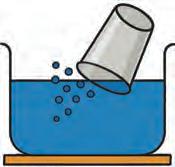
(a) Air takes up (space/shape) inside the glass and pushes the water away.
(d) Bubbles always rise up in water because the air trapped inside make them (heavier/lighter) than water.
3.
State True/False.
(a) Trapped air can act as a protective layer between water and an object.
(b) The experiment shows that water can enter a space even if air is present.
(c) Only paper objects can stay dry using trapped air.


MagIc Spoon
In this activity, we will see how a plastic spoon can pull tiny black pepper flakes.
What We Need
1 tablespoon of black pepper flakes
1 plastic spoon 1 plate
Let’s Begin

Take 1 tablespoon of black pepper. Sprinkle it evenly on the plate. 1.

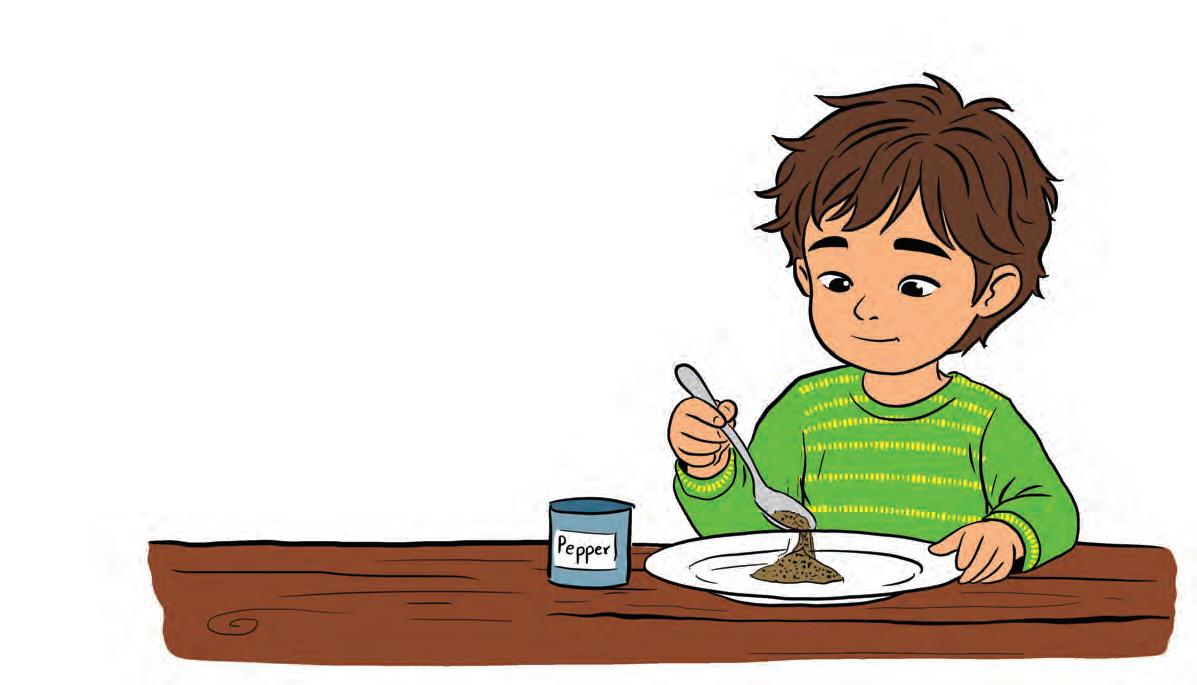
2.
Rub a plastic spoon on your hair for a few seconds.
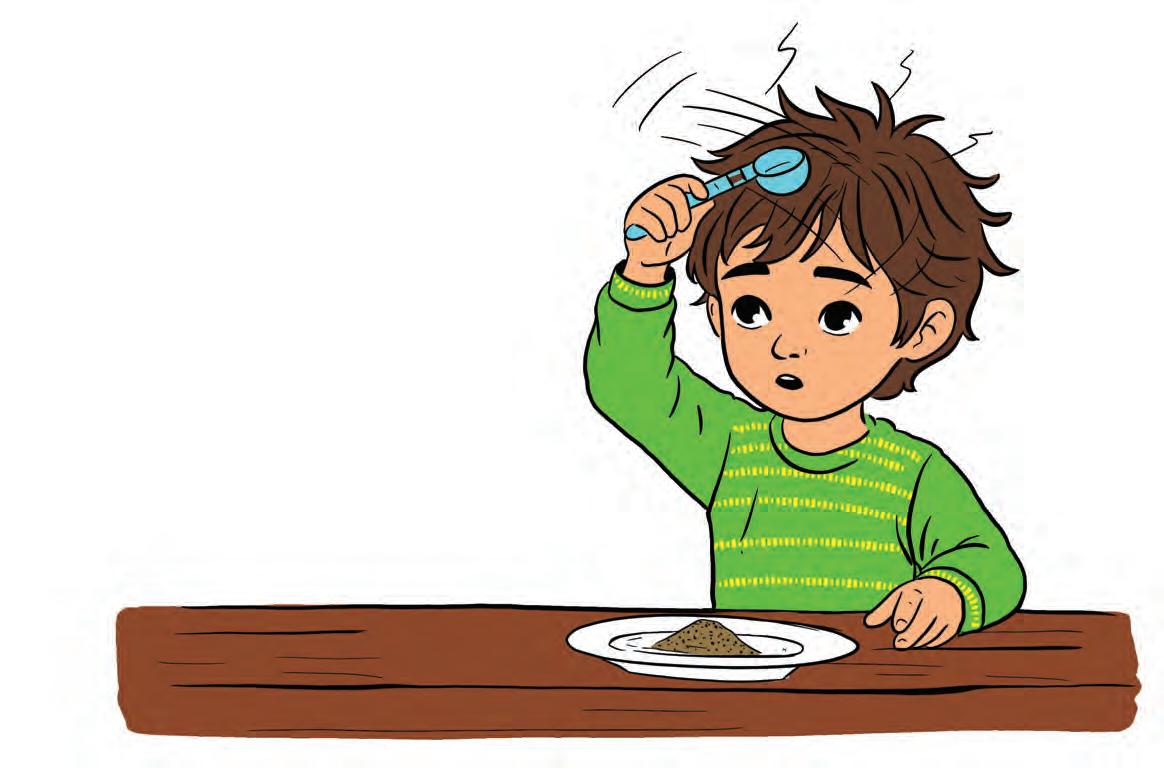
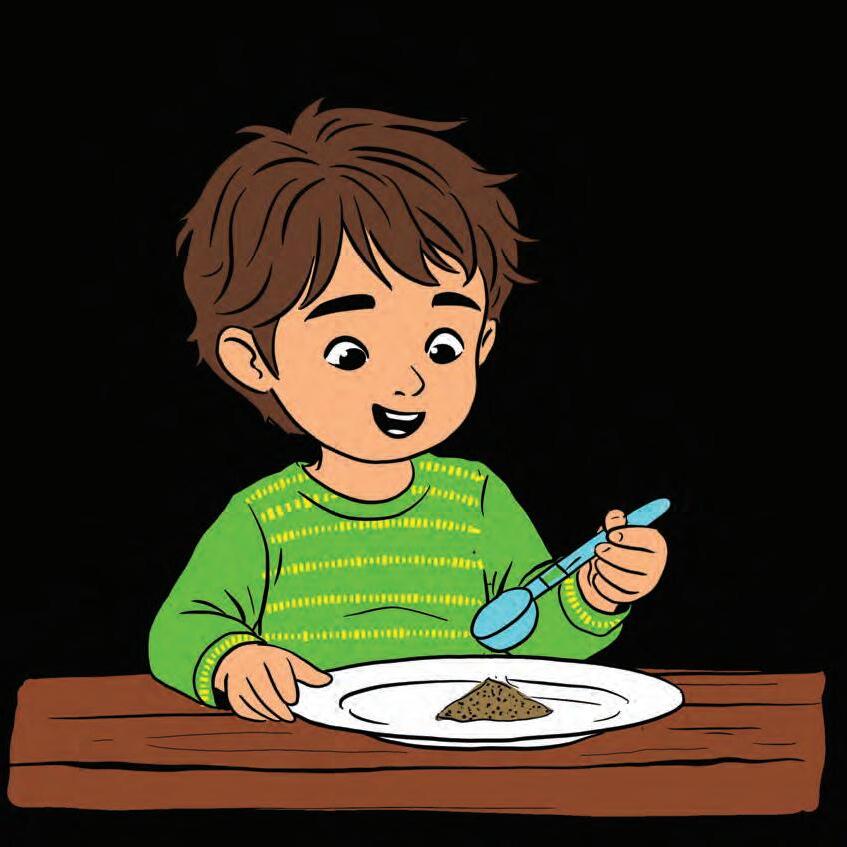
3.
Now, gently bring the spoon closer to the pepper on the plate.
Make sure the spoon and the pepper stay dry. Watch out

flakes will jump and stick to
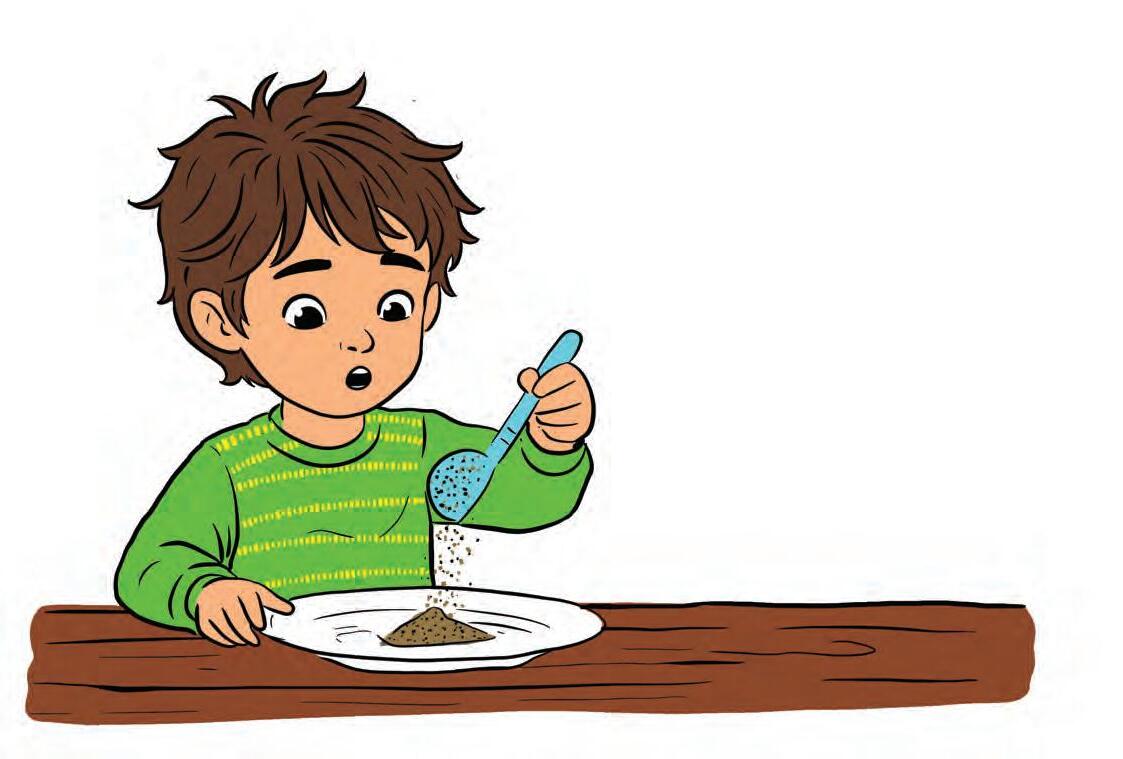
Activity in Action
ScIence BehInd It...
When you rub a plastic spoon on your hair, it gains an invisible force that can pull light objects like pepper toward it without touching them.
Find Out More!

Try the activity with salt, sand, bits of paper, coins and pebbles. Observe carefully and note which items are pulled up and which are not. See which one the spoon pulls the most.
Check your learnIng!
1. Tick ( ) the correct answer.
The spoon becomes sticky. The spoon gets an invisible force. (a) (b)
B.
Pebbles (a) (b)
Small paper pieces
2. Fill in the blanks.
A. A.
B. Why does a plastic spoon pull pepper towards it after rubbing it on your hair?
A ______ (plastic/wooden) comb can pick up small pieces of paper after rubbing it on your hair.
When you rub a balloon on your hair, it can make your hair ______________ (move toward the balloon/move away from the balloon).
3. You want to test which material – pepper, sugar or salt — sticks best to a rubbed plastic spoon. Arrange the steps in the correct order (1–4) to do the activity.
A. Slowly bring the spoon close to each plate. Sprinkle equal amounts of each material on separate plates. Observe which material jumps and sticks the most. Rub a plastic spoon on your hair. (a) (b) (c) (d)
B. Which objects are most likely to be pulled by a rubbed plastic spoon?
If you try this activity outdoors on a humid day, do you think the materials will stick to the spoon? Why or why not?

OptIcal IllusIon Toy
In this activity, we will make a magical illusion toy that makes two drawings appear as one when you spin it fast.

What We Need
A pencil/wooden stick
A pair of scissors
A drawing sheet
Glue or tape
Sketch pens or crayons

Let’s Begin


On one square, draw a fish and colour it in.
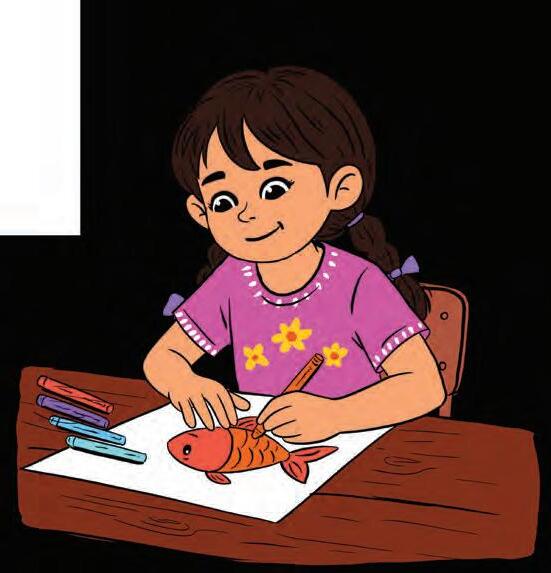
On the other square, draw a big bowl of water and colour it in. 3.
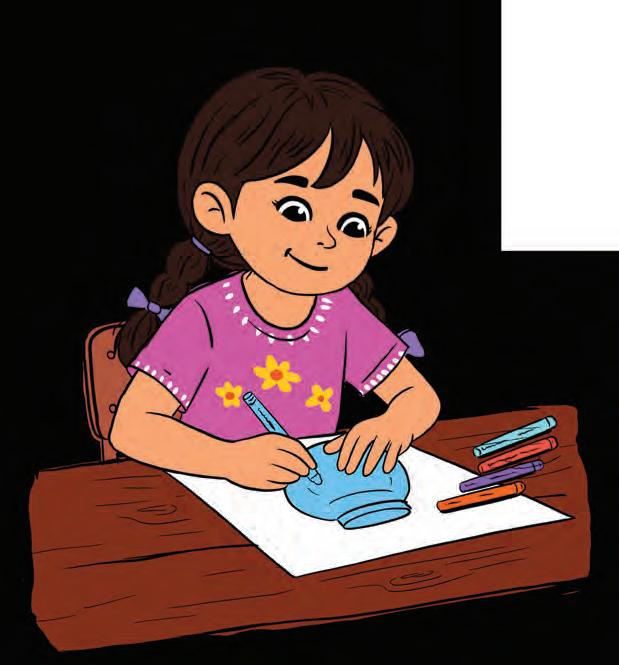
Rub the pencil quickly between your palms to make the squares 5.

DId You Know?
?
The optical illusion toy was invented in the 1800s and is called a thaumatrope — one of the earliest forms of animation!
4.
Use glue or tape to stick the two squares around the top of a pencil.

Spin the toy keeping it away from your face. Watch out


ScIence BehInd It...
This toy shows how our eyes and brain work together. When it spins fast, our eyes cannot see the two pictures separately. The brain joins them, creating an illusion, so they look like one moving picture.
Find Out More!
Watch how the fish appears to swim inside the bowl as the squares spin. 6.
Activity in Action
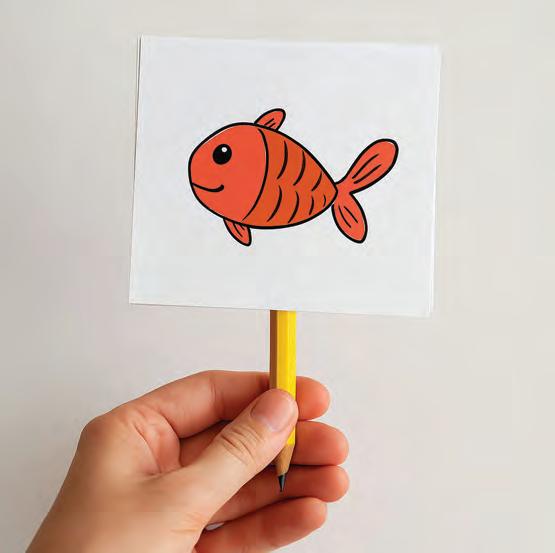
Draw a spider on one square and a web on the other. Spin the toy quickly and watch the spider move onto its web.
Check your learnIng!
1. Ria has a toy made from two paper squares on a pencil. One square has a black sky, and the other has bright stars. When she spins it fast, it looks like a starry night. This toy is called a thaumatrope.
Answer the below questions based on the above reading.
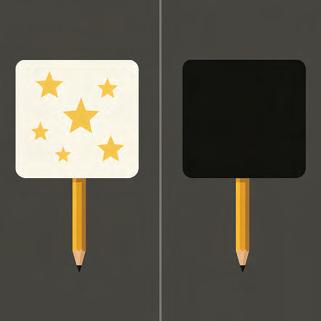
What happens when Ria spins the toy fast?
She sees a bright rainbow. She sees a starry night.
B. What is the name of this toy?
Microscope
Thaumatrope
C. A thaumatrope shows A real picture A trick picture (illusion)
D. Which parts of our body help us see the two pictures as one?
Eyes and brain
Hands and legs
E. How did toys like the thaumatrope help people long ago? They helped people learn how to create movies. They helped people learn how to make paintings.
A. (a) (b) (a) (b) (a) (b) (a) (b) (a) (b)

Magnet Maze challenge
In this fun activity, we will use a magnet to guide a game piece through a maze without touching it.
What We Need
• A piece of cardboard
• A white sheet
• A pencil

T Using magnets A Drawing a maze

S Objects can be moved using magnetic force
• A black marker
• A pair of scissors
• A paper clip
• A small magnet
• Crayons
• Gluestick
Let’s Begin

1. Take a square shaped cardboard and paste a white sheet on it.

2. Draw a simple maze and trace it with a black marker.
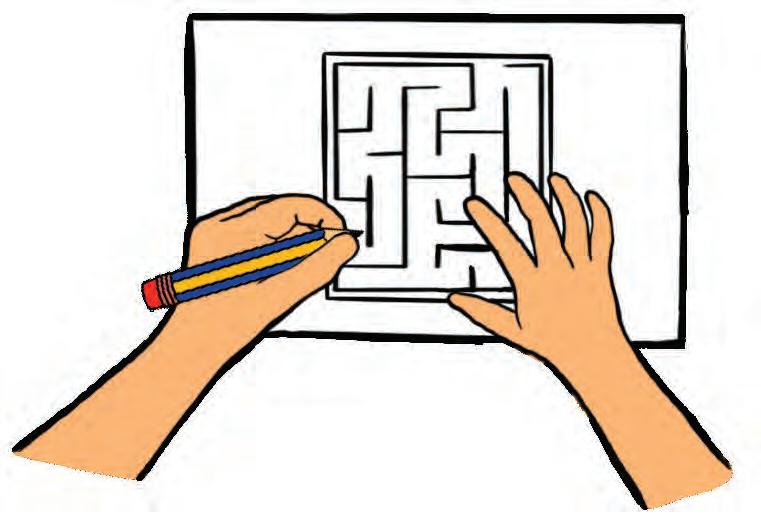
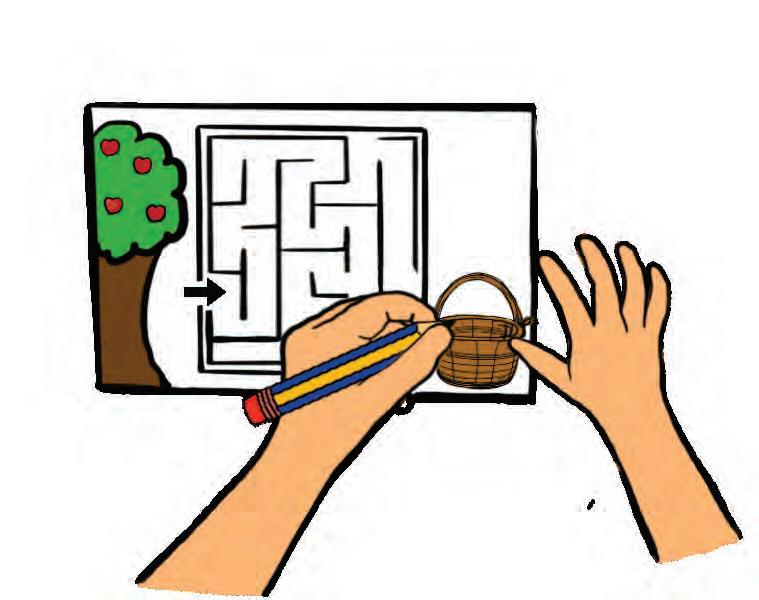
4. Cut out a small apple shape from cardboard and colour it in to use as your game piece.

3. Draw and colour in an apple tree at the start and a basket at the end of the maze.
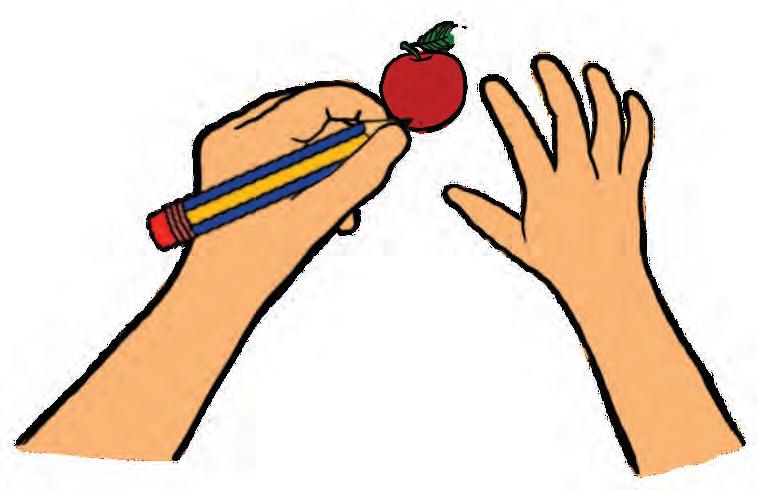
5. Glue a paperclip to the back of the apple cutout. Watch out
Make sure the apple is firmly glued to the paperclip so it doesn’t fall off.

6. Place the apple shape at the start of the maze and use a magnet under the cardboard to guide it through the maze.
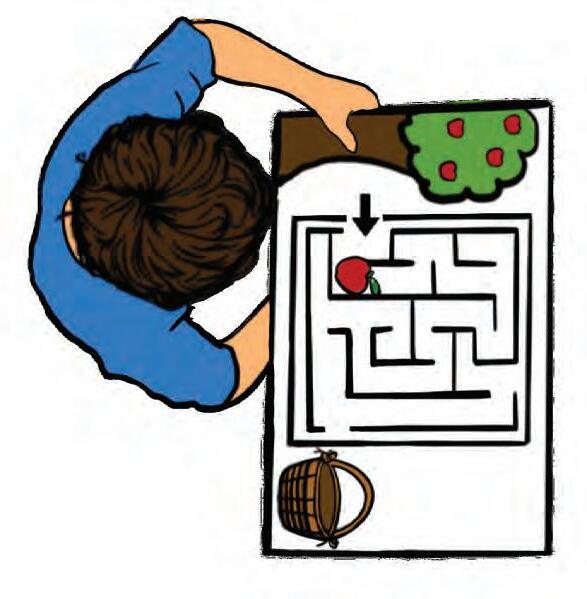
SCIENCE BEHIND It...
The magnet moves the apple with a paperclip through the maze because magnets can pull objects made of iron or steel, even without touching them.
Find Out More!
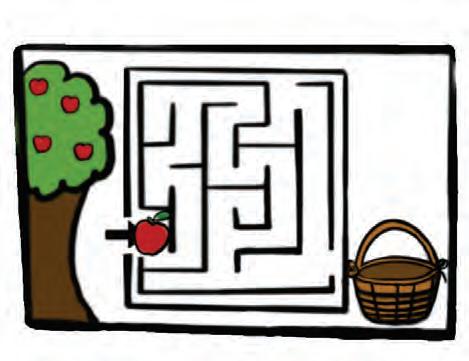
7. Carefully move the apple through the path until it reaches the basket.
Activity in Action

Try using different items like a coin or a key. Does each one move the same way when you use the magnet?
Check your learnIng!
1. Tick ( )the correct answer.
A. What will happen if we remove the paperclip from the apple piece?
(a) The apple will move with the magnet.
(b) The apple will stay in one place.
B. Rohan does not have a paperclip to attach to his game piece. Which of these could he use instead so the magnet can still move it through the maze?
(a) Plastic button (b) Steel safety pin
2. Tick ( ) the materials that a magnet can pull.


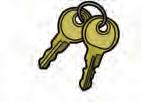
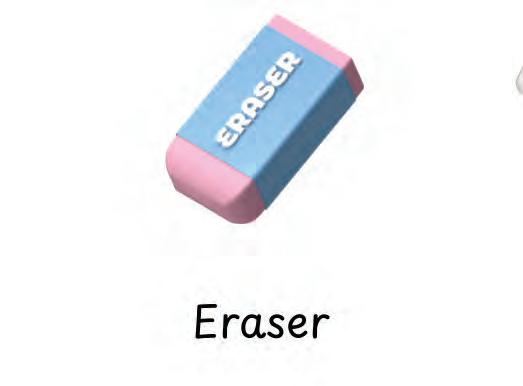





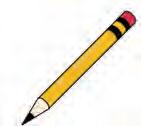
3. State True or False.
When you open the door of a refrigerator and let it go, it closes tightly because of the magnet inside the door seal.


Paper Clip
Iron Spanner
Metal Keys Glass Crayons
Rubber Band
Eraser Spoon
Nail Pencil
WATER GLASS XYLOPHONE
In this fun activity, we will make water xylophone by tapping the glass jars filled with different amounts of water and hear the music.
What We Need


Metal spoon
6 identical glass jars
A paintbrush
Let’s Begin
Place 6 glass jars of the same size on a table in a line. 1.

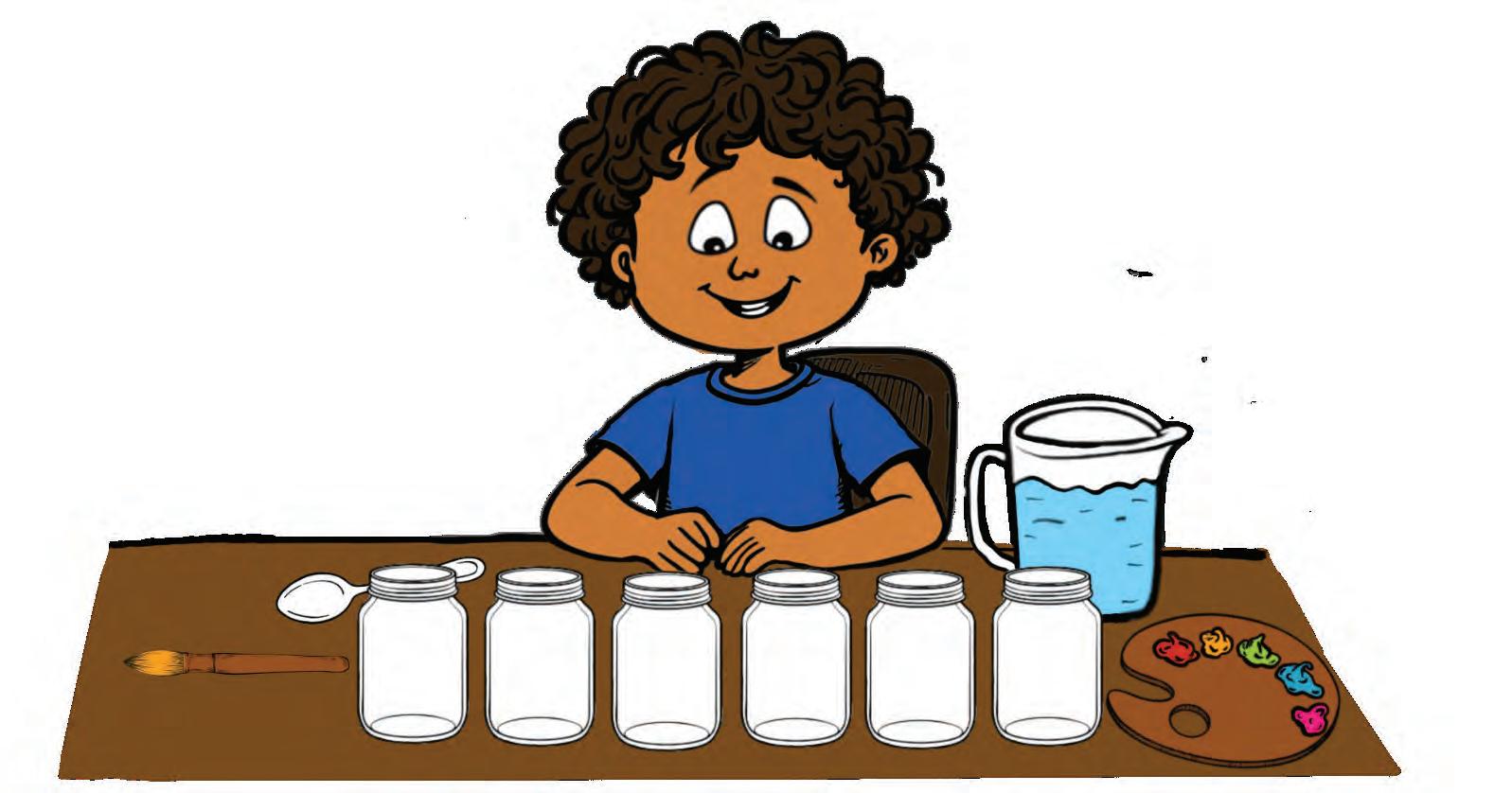
Leave the first jar empty. Pour a little water in the second jar, more in the third, even more in the fourth, and so on. 2.
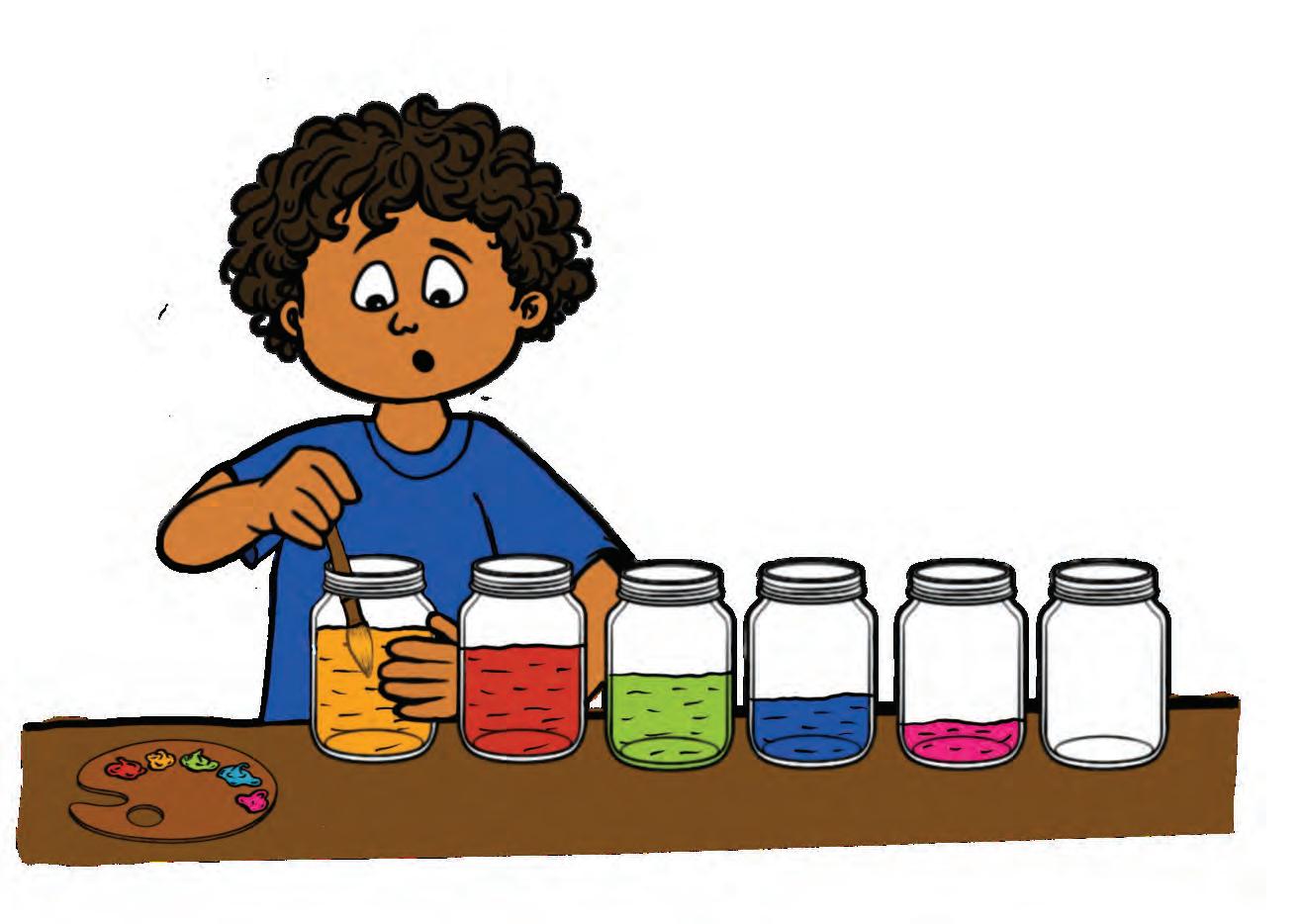
DId You Know?
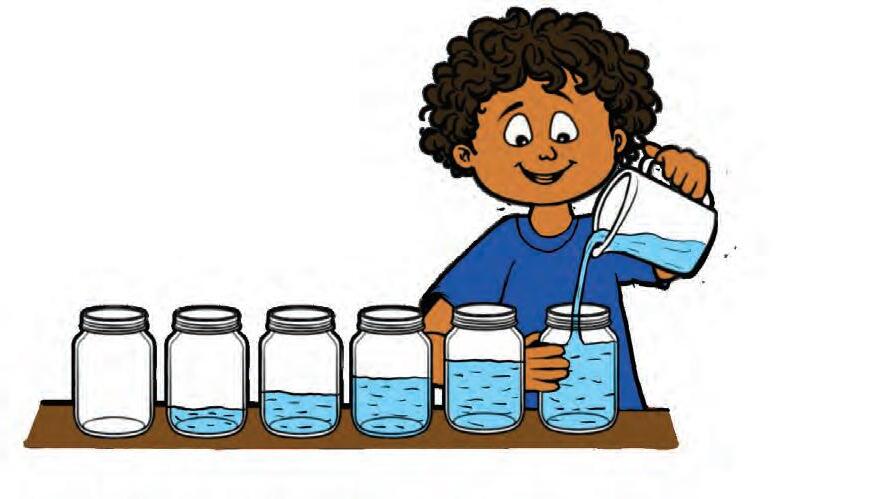
Mix different water colours in the jars having water using a brush. 3. ?
A xylophone is a musical instrument with bars of different sizes. When you hit them, each bar makes a different sound.
Tap each jar gently with a metal spoon and hear the music. 4.
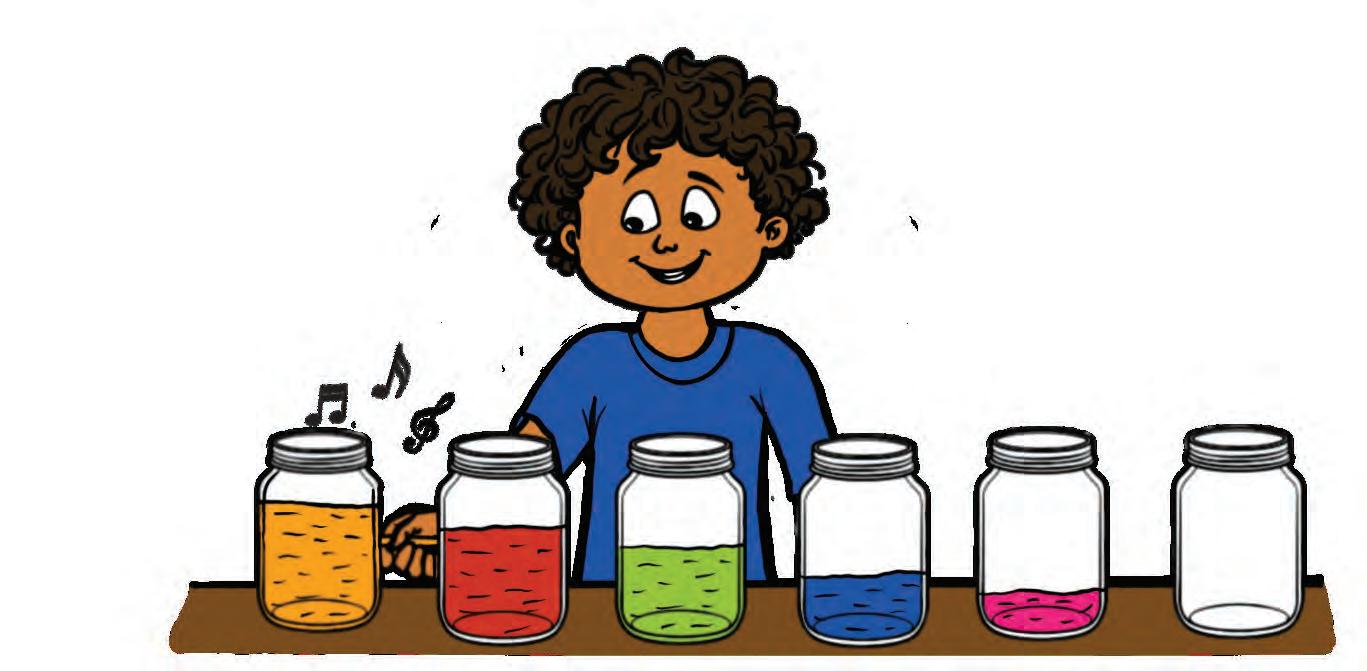

Tap the jars in a different order to create your own tune. 5.

Do not hit the jars too hard. Watch out
ScIence BehInd It...
Tapping the jars makes them vibrate and produce sound. Changing the amount of water changes the sound. Less water makes a high sound and more water makes a low sound. This is how a water glass xylophone works. Find Out More!
Activity in Action
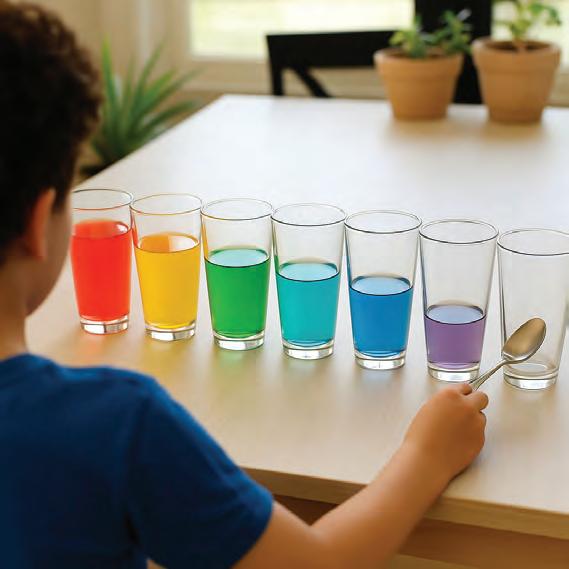
Fill one glass with warm water and another with cold water. Tap both glasses gently. Can you hear a difference in the sound?
Check your learnIng!
1. Akshat was playing music by gently hitting spoons on identical glass jars filled with different amounts of water. It was fun to see that each jar made a different sound.
A.
How does tapping the jar produce sound?
(a) The glass vibrates and makes sound.
(b) The water has music inside.
Why did each jar make a different sound? B.
2.


Symmetry PaIntIng MagIc
In this activity, we will learn about symmetry by creating a colourful painting that looks the same on both sides.
What We Need
• A drawing sheet
• A pencil
• A paintbrush
• Watercolours

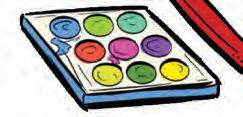

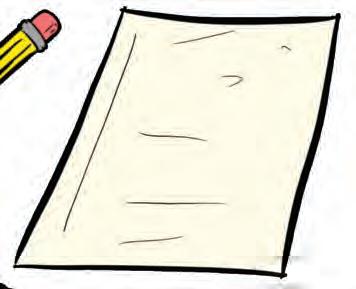
Let’s Begin


1. Fold the sheet in half. Open it to see the line in the middle.
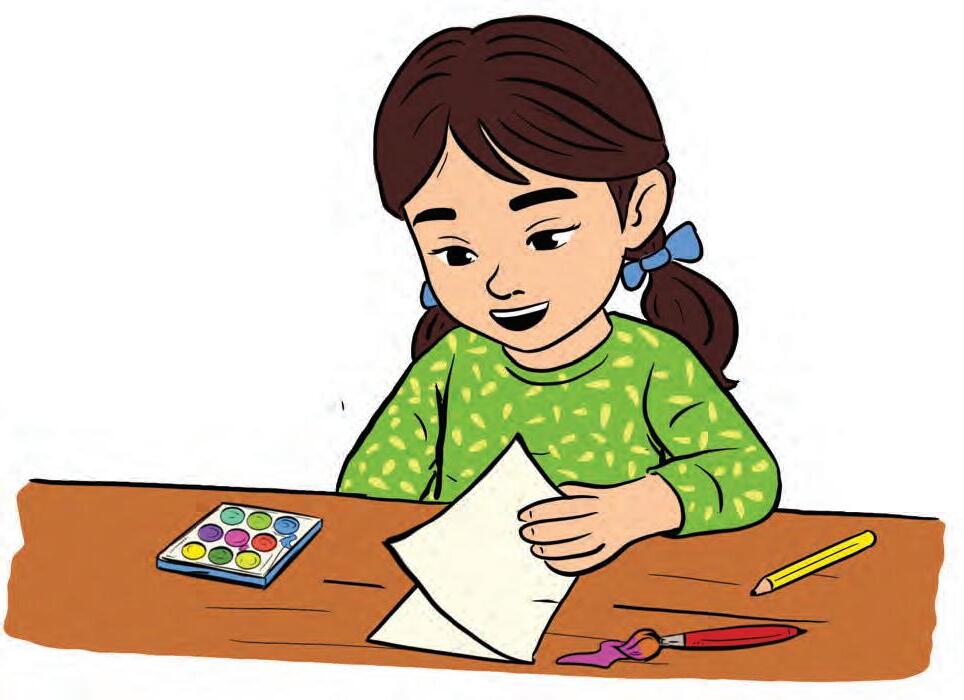

Use a pencil to draw one half of a butterfly on one side, starting from the fold.
3. Paint the drawn half using watercolours.
4. Fold the sheet again and press gently.


Watch out
Make sure the paint is wet and thick, so that it can transfer to the other side.

5. Now, open the sheet. You will notice the two wings of the butterfly have the same shape and design.
SCIENCE BEHIND It...
When you fold the sheet, the wet paint sticks to the other side. This makes both sides look the same like a mirror. This is called symmetry. Find Out More!

Activity in Action
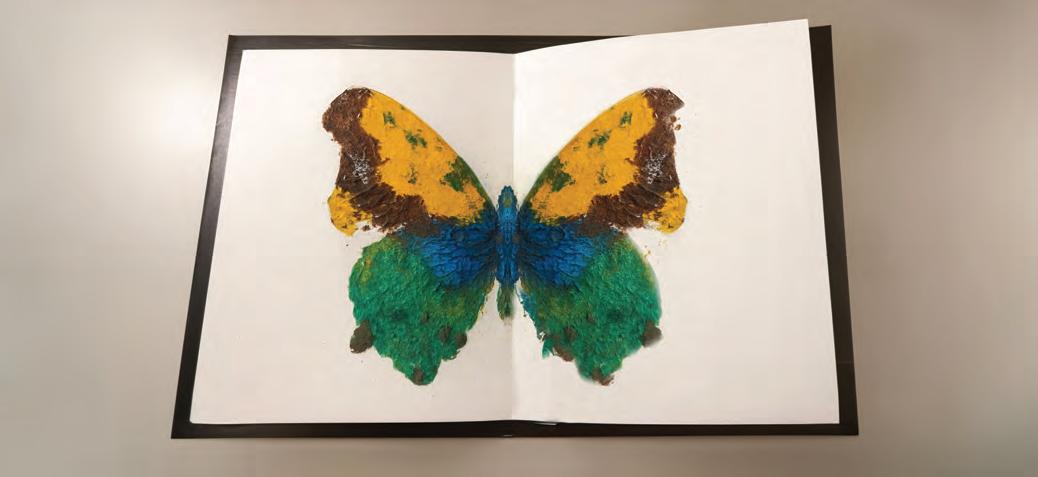
Paint a design in one corner of the paper. Fold top to bottom and open. Then fold side to side and open to see the design in all four parts.
1. Match and colour the other symmetrical half.
2. Tick ( ) the images that show symmetry.
3. Draw the missing half to make the picture symmetrical.

Straw Raft
In this activity, we will make a raft using straws and check if it floats or sinks in water.

• 5 plastic straws
• Coins
• Glue
• A big bowl
• Water What We Need
Let’s Begin

S Sink and float E Building a straw raft M Counting coins

1. Take 5 plastic straws and lay them next to each other on the table.
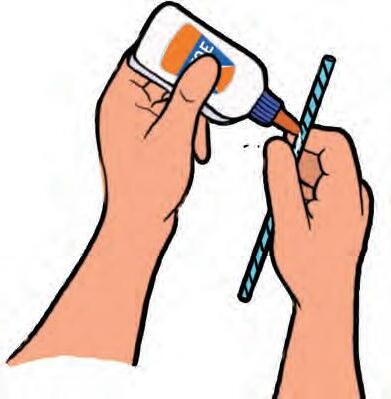

2. Apply glue along the sides of each straw.
3. Stick the straws together to make a flat raft.
Watch out
Wait for the glue to dry completely.

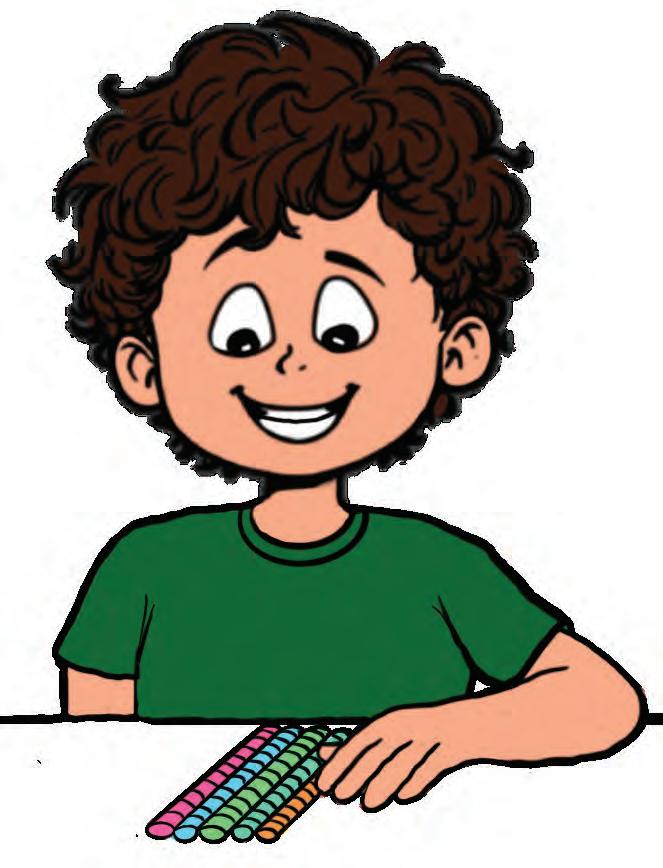
Fill a big bowl with water.
5. Gently place the straw raft on the water and watch it float.



Activity in Action
6. Put coins on the raft one by one. Count how many it can hold before sinking. Find Out More!
SCIENCE BEHIND It...
The straw raft floats because the air inside the straws makes it lighter. Adding coins increases the weight, pushing the raft lower in the water. The raft sinks when the weight becomes too heavy for the water to hold.
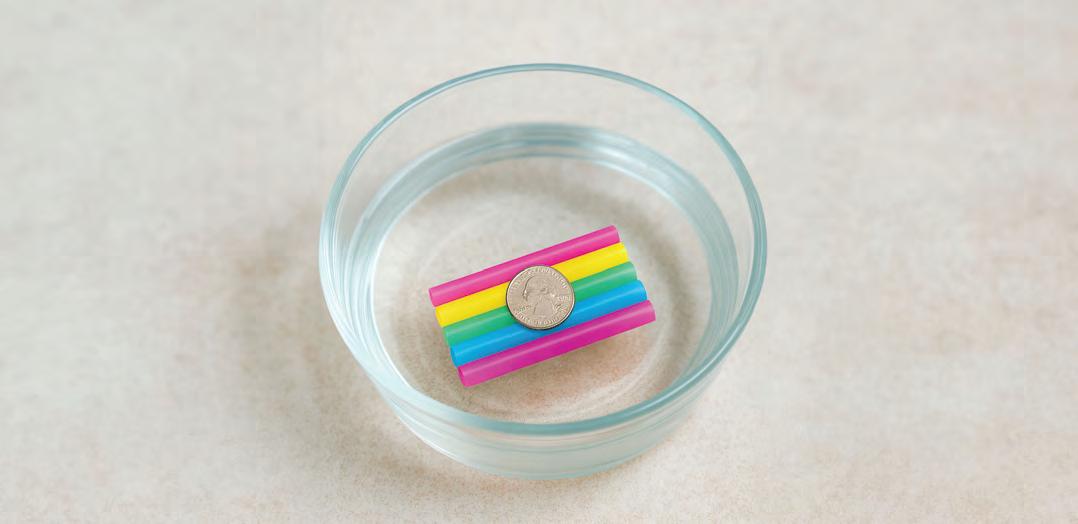
Keep adding weight to your raft. If it starts to wobble or fall, make it stronger by adding more straws to help it stay steady.
1. Tick ( ) the correct answer.
A. Which of the two straw rafts will hold more coins before sinking? (a) 7
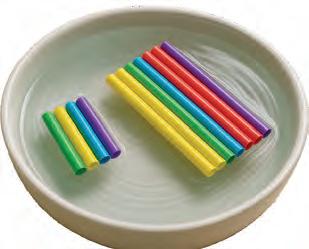
(b) 4
B. Which one shows a raft used by fishermen to cross rivers?

2. State True/False.
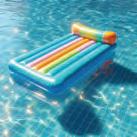
(a) The raft floats because the straws are filled with water.
(b) Ad ding more coins will make the raft sink.
3. Colour the raft as shown in the picture.


Bubble MachIne
In this fun activity, we will make a bubble machine and explore how air can help us blow big and floating bubbles.
What We Need
• 2–3 straws
• Liquid dish soap
• A bottle
• A cardboard
• A pair of scissors
• A pencil
• A bowl
• Gluestick/Tape
Let’s Begin
1. Ask an adult to cut the bottle a little above the middle.
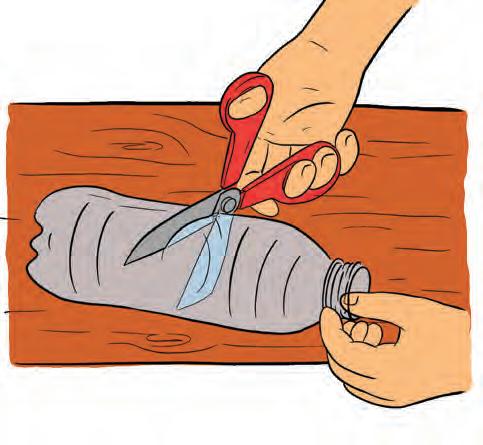
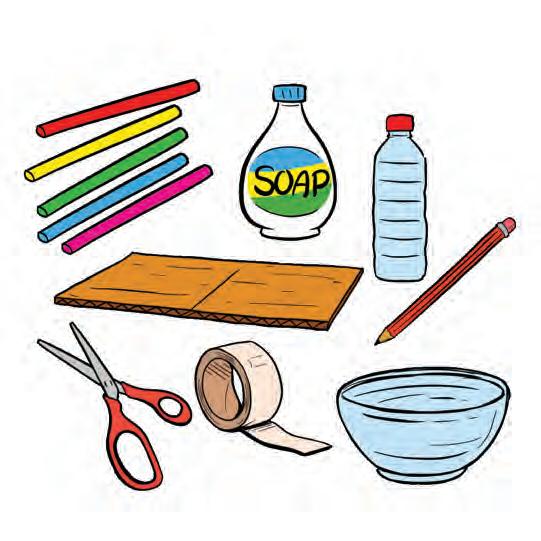
2. Place the bottle top on the cardboard and draw a circle around it with a pencil.
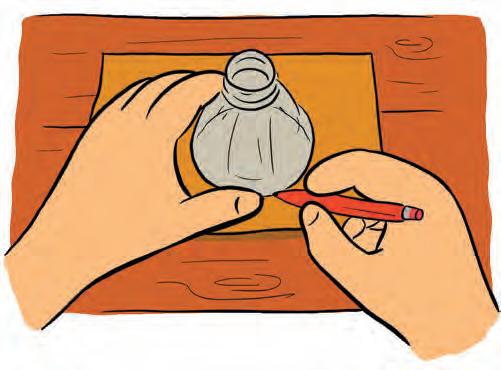
3. Cut out the cardboard circle.
4. Poke small holes in the cardboard circle using a pencil.

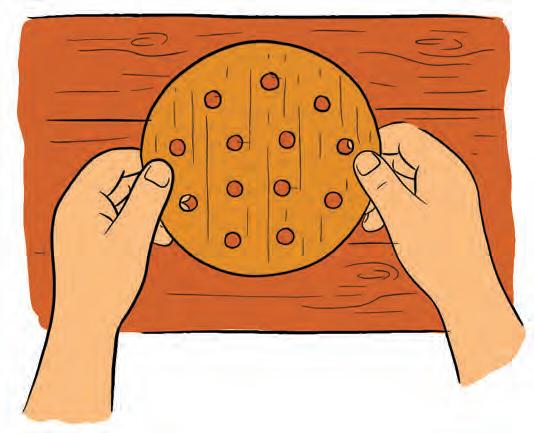

Watch out
Make sure the holes are just big enough for the straws to fit.
5. Cut straws into small pieces and insert one into each hole.

Stick the cardboard with straws onto the mouth of the bottle using glue or tape.

7. Mix soap and water in a bowl. Dip the straws of your blower into it.
8. Blow from the top of the bottle. Watch lots of bubbles appear and float.
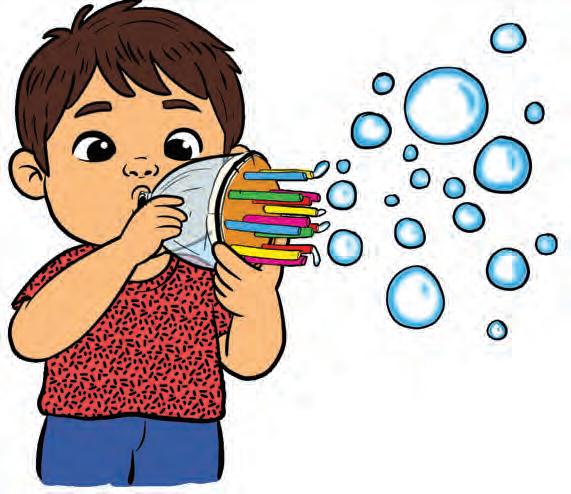
Activity in Action

SCIENCE BEHIND It...
When you blow air through the straws, the air passes through the soap water and the soap traps the air inside a thin film, creating a bubble!

Mix a little water colour into your soap water. Do the bubbles look different now? Find out More!
1. Think and write.
I am round but not a ball, I float in the air and can pop and fall.
I am ma de of soap and a little air, Sh iny colours are what I wear.
What am I?

2. Lo ok at the picture and tick ( ) the correct answer.
A. Which bubble maker will form more bubbles?
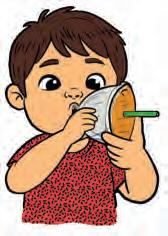
3. State True or False.
A. Air is n eeded to make bubbles.

B. A bubble is filled with air and covered with a thin soap film.
C. Blowing too hard can break the soap film before it forms bubbles.
D. If the cardboard gets wet and bends, the blower might n ot work well. (a) (b)

Star ProJector
In this fun activity, we will make our own star projector and see the star patterns on the wall.



• A big paper cup
• A pair of scissors
• A push pin
• A pencil
• Tape
• A torch/mobile flashlight
• A white drawing sheet What We Need
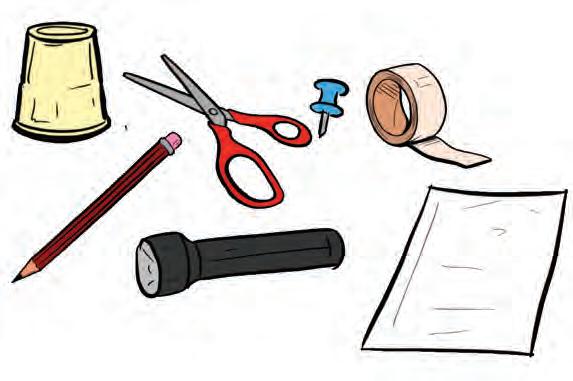
1. On a white sheet, trace a circle using the bottom of a paper cup.

2. Draw the ‘Big Dipper’ star pattern inside the circle. Ask an adult to help you cut it out carefully.

4. Use a push pin or sharpened pencil to carefully poke holes through each dot of the star pattern.
Watch out
Make sure the pin goes through both the paper and the bottom of the cup.
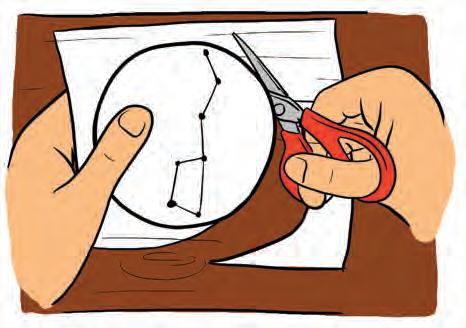
3. Stick the Big Dipper cut out to the bottom of the cup.

5. Turn off the lights and close the curtains to make the room dark.


DId You Know?

The Big Dipper is a group of seven bright stars that form a shape like a big spoon in the night sky. It is part of a larger constellation called Ursa Major (the Great Bear) and is easy to spot.


6. Shine a torch into the cup and watch the star pattern appear on

SCIENCE BEHIND It...
When you shine a flashlight into the cup, the light passes through the tiny holes you made. Each hole acts like a star. The light shines onto the wall and makes a pattern in the dark. A group of stars that forms a pattern in the sky is called a constellation.
Activity in Action
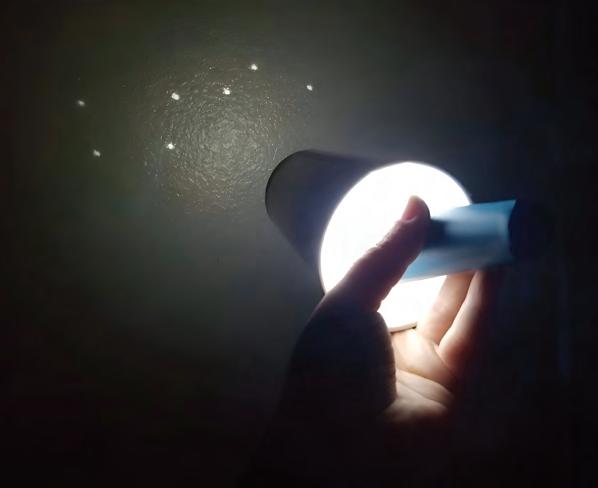
Make different star patterns and project them on the wall using your star projector. Find out More!
Check your learnIng!
1. Tick ( ) the correct answer.
Rahu l was walking outside with his father at night. His father pointed to the sky and said, ‘Look Rahul, that is Orion.’ People long ago used star patterns to tell the time and find directions. Then Rahul pointed to another pattern. His father smiled and said, ‘Well done, this is the Big Dipper. It is part of the constellation Ursa Major’.
A. What is a constellation?
(a) A g roup of planets making a pattern
(b) A g roup of stars making a pattern

B. Why don’t we see star patterns during the day?
(a) The sun’s light is too bright to see the dimmer starlight.
(b) Stars disappear during the daytime.
C. The Big Dipper is part of which constellation?
(a) Ur sa Major
(b) Ur sa Minor
D. How did ancient people use constellations?
(a) To know about time and directions
(b) To measure the distance to the sky
2. State True or False.
(a) Stars make their own light.
(b) The Moon is also a star.
(c) Stars disappear during the day and only shine at night.

BalancIng wIth Water Power
In this activity, we will learn how water can help balance objects and keep them in place.
What We Need
Water
A glass
A card or thick paper
A small object like an eraser or a coin
Let’s Begin
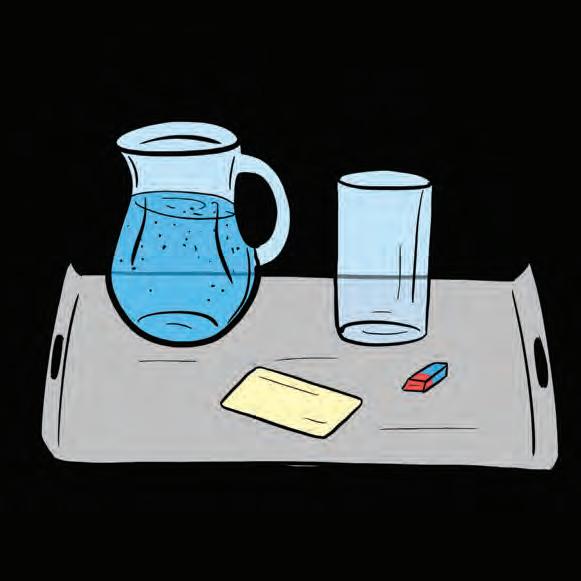

Place an empty glass on 1. Put a card or small thick paper on top of the glass with 2.
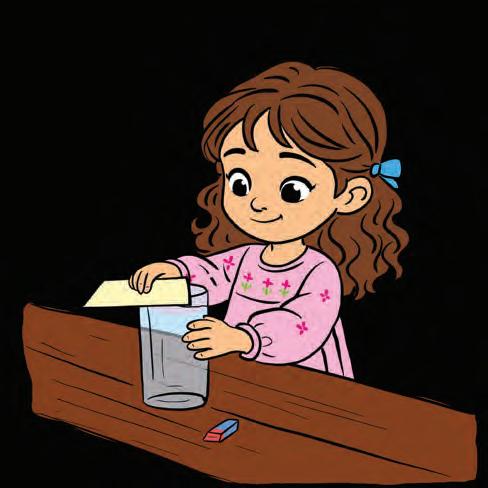
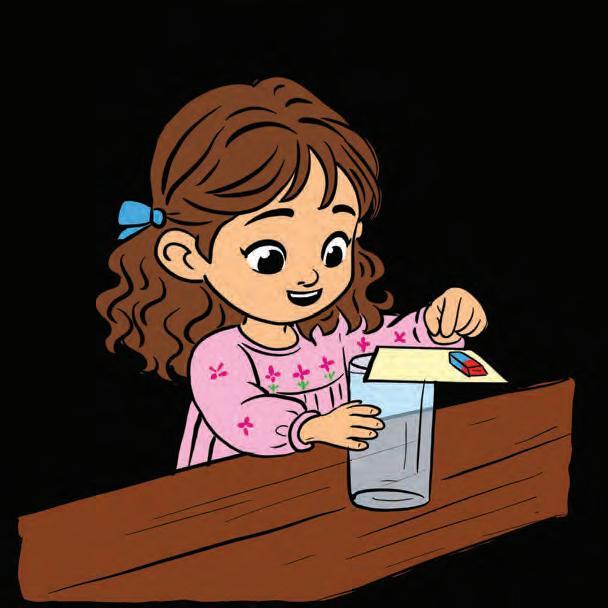
Place an eraser on the part of the card outside the glass.
4.
Notice, how the card and the eraser fall.

Now fill the glass with water up to the top.
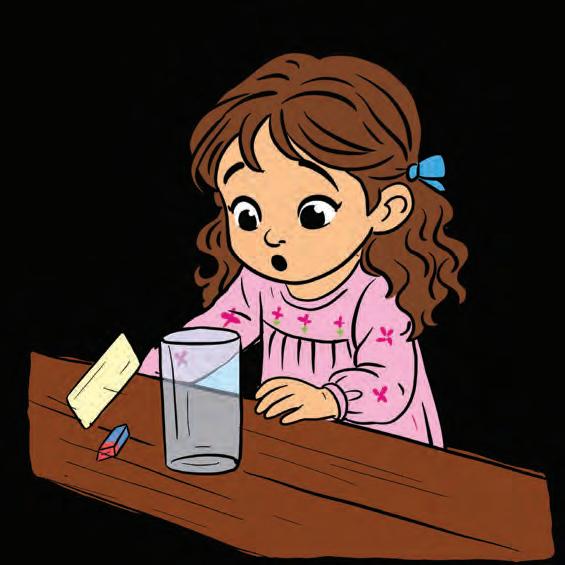
Watch out
The water must reach the brim
6.
Place the card on the filled glass again so it touches the water, but with half outside.
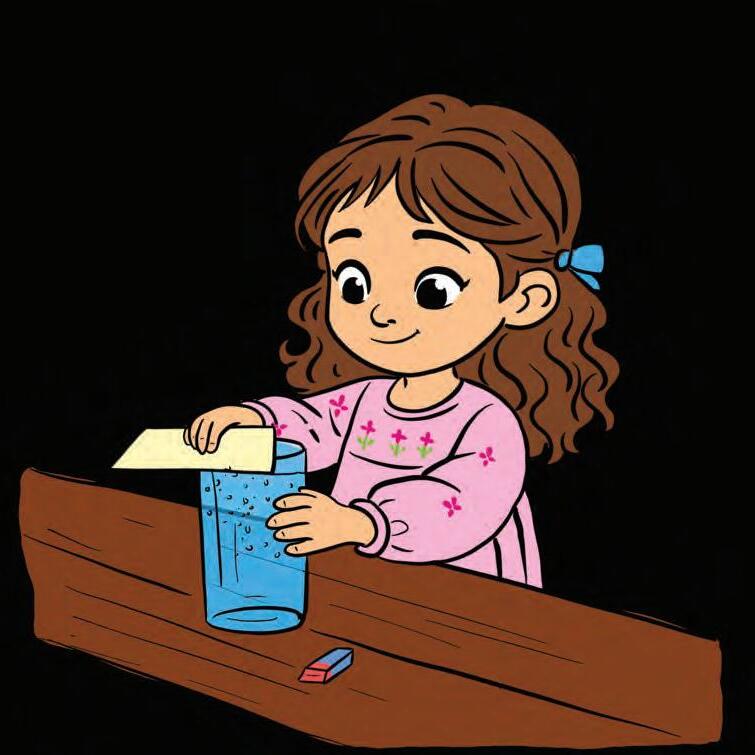

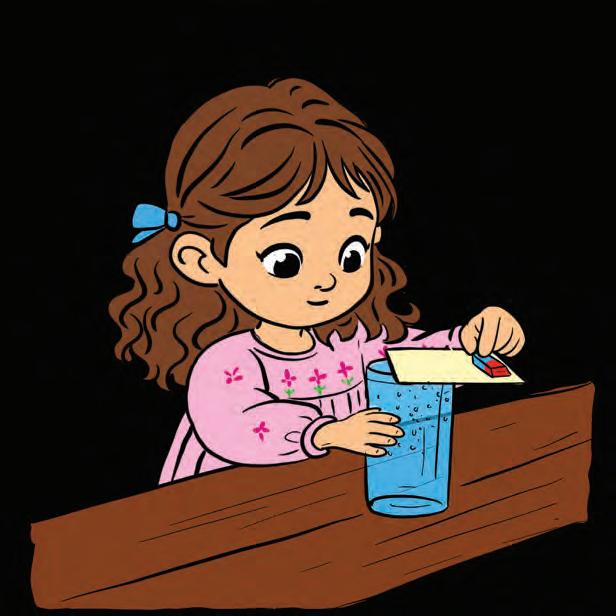
Put the eraser on the part of the card outside the glass again.
Watch carefully — this time, it does not fall. 8.
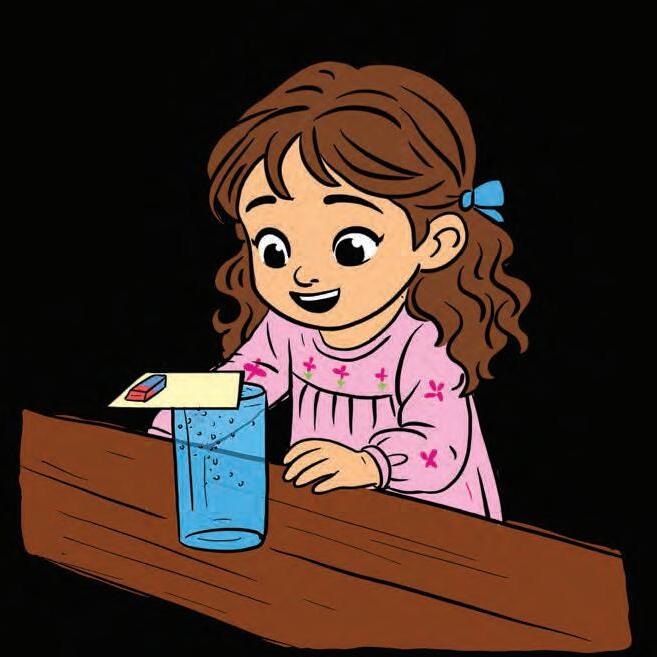
ScIence BehInd It...
Water forms a strong, thin layer on its surface that supports objects by holding them evenly from all sides. This helps objects stay balanced without sinking or tipping over. Find Out More!
Activity in Action

Balance other small objects like a coin, button or marble on the card to see which ones stay and which ones fall.
Check your learnIng!
1.
A. Rohan wants to see how water helps objects balance. Which setup will help him observe this properly?
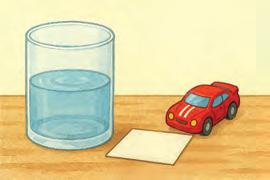
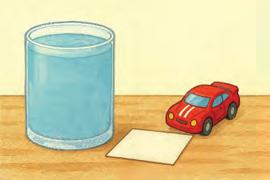
B. Why did the car fall in the case of the half-filled glass?
(a) There was not enough water to support the car on the card.
(b) The card was too weak to hold the car.
2. Fill in the blanks.
(a) (b) (c) (d)
Water forms a (thin/thick) layer on its surface that can hold small objects.
Water helps objects (float/sink) on its surface.
A pebble sinks in water because it is (lighter/heavier) than what water can hold.
A boat does not tip over easily because the water helps to keep it . (balanced/unbalanced).
3. State True/False.
Leaves and paper boats can float on water because water has a thin, invisible layer on top that can hold up light things.



My Own SpInnIng Top
In this activity, we will make a spinning top and learn how it spins and stays balanced.
What We Need
• A toothpick
• A pair of scissors
• Cardboard
• Coloured chart paper (any 2 colours)
• Glue

1. Ask an adult to cut two cardboard circles – one big and one small.
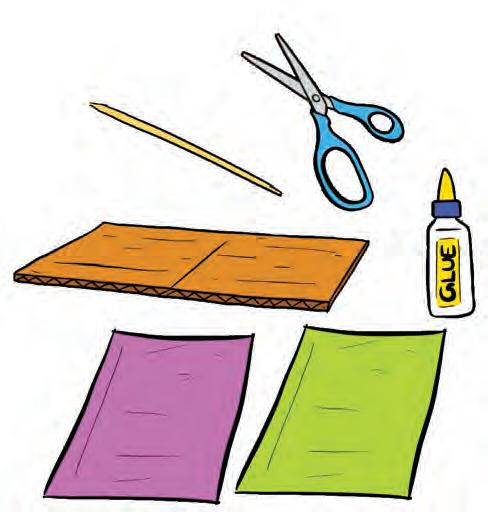

2. Cut coloured paper circles of the same size and paste them on the cardboard circles.


3. Take a toothpick and make a small hole in the centre of
4. Paste the smaller circle on top of the bigger one, keeping their centres in line.


Now, carefully push the toothpick through the middle of the two circles.

DId You Know?

Spinning tops are one of the oldest toys in the world. They were found in ancient Egypt and Greece!


6. Spin your top and watch it twirl. Measure how long it spins.
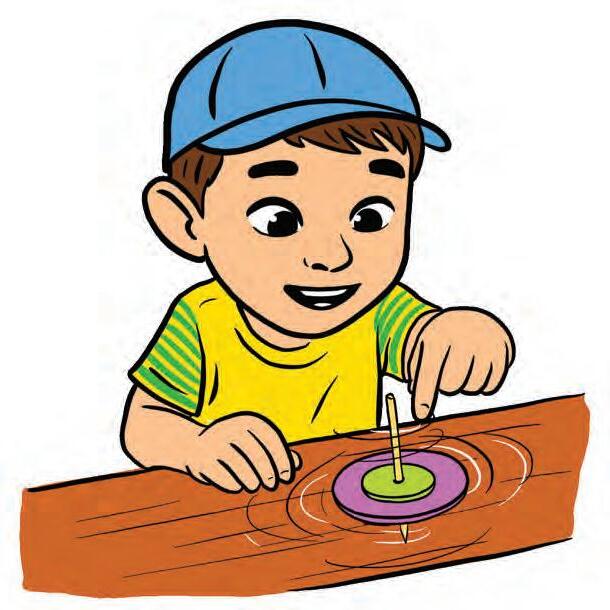
Activity in Action
Watch out
Spin your top on a flat surface.
SCIENCE BEHIND It...
The top spins fast on its tip and stays balanced. After some time, friction (rubbing with the floor surface) slows it down and makes it fall.
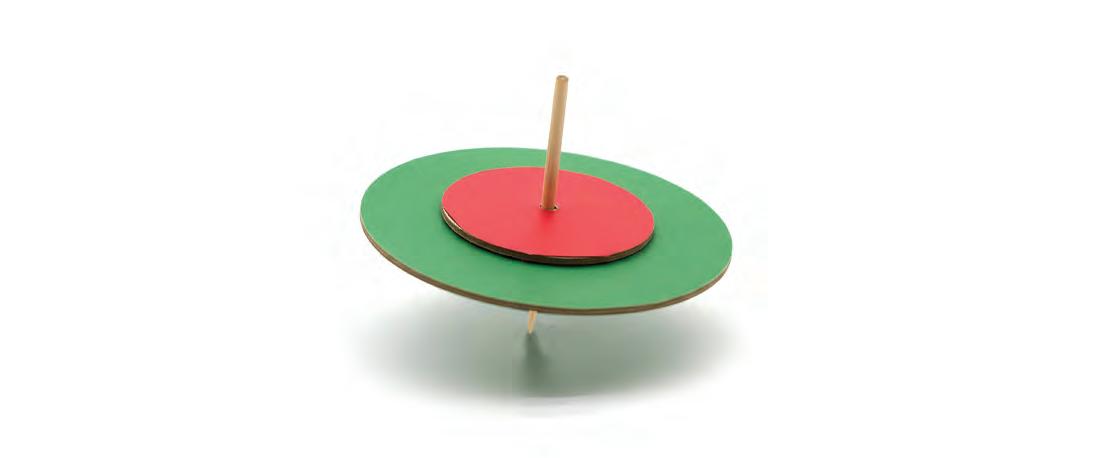
Spin your top slowly and then quickly. See which one spins for a longer time. Find out More!
Check your learnIng!
1. Tick ( )the correct answer.
A. Aarav spins his top very fast. What will happen after some time if he does not touch it?
(a) It will keep spinning forever.
(b) It will slow down and stop.
B. Aarav wants his top to spin longer. Which of these will help?
(a) Spinning it gently on a rough surface
(b) Spinning it faster on a smooth surface
2. Fill in the blanks.
(a) The top stays balanced when it (spins/stops).
(b) The hole in the top should be at the (centre/edge) of the circle.
(c) A (rough/smooth) surface makes the top slow down faster.
3. State True or False.
(a) Wind turbines and fans also rotate around a centre like a spinning top.
(b) The Earth spins like a top on its axis, giving us day and night.


Phases of the Moon
In this activity, we will learn about the different phases of the moon.
What We Need
1 paper cup
1 black chart paper
1 sketch pen
Drawing sheets (2 white, 1 coloured)
A pair of scissors
Crayons
A glue stick With

Let’s Begin
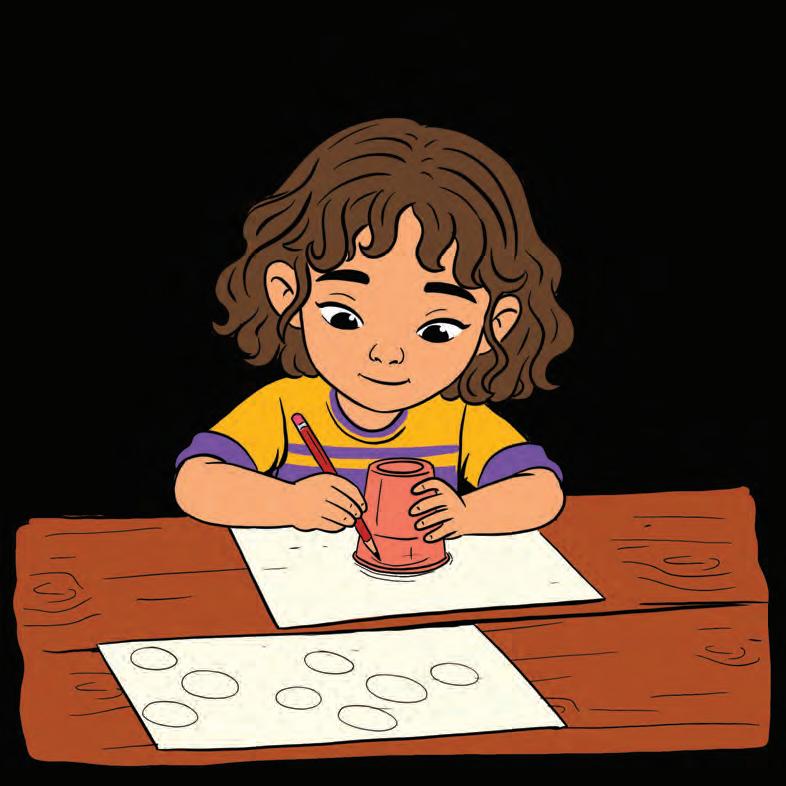
Color the big circle blue and green like Earth. Paste it in the middle of the black chart paper. 2.

Colour the other circles to show the different phases of the Moon as follows: 3.




• Waxing Gibbous: Colour a small part on the left black, leaving most of the circle white.
• Full Moon: Keep the circle fully white.




DId You Know?
The Moon goes through all its phases in about 29 and a half days.
4. Paste the 8 moon phases around Earth and stick the name slips next to each one.
Order of the Phases:

ScIence BehInd It...
The Moon does not make its own light. We see it shining because sunlight falls on it and bounces back to us. As the Moon moves around Earth (revolves), we see different parts of its bright side. This makes the Moon look as if it is changing shape. These changes in shape are called the phases of the Moon.
New Moon Waxing Crescent
First Quarter Waxing Gibbous
Full Moon Waning Gibbous
Last Quarter Waning Crescent back to New Moon.
Do not change the order of the phases while pasting. Watch out
Activity in Action
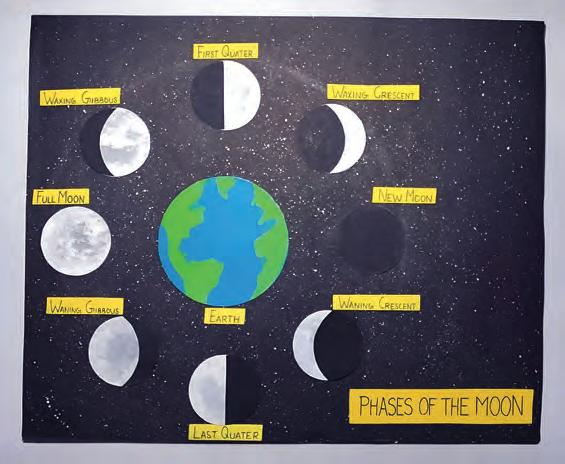
Find Out More!
Look at the moon every night for a month and draw its shape on a calendar. Write down if the moon is getting bigger (waxing) or getting smaller (waning).

Check your learnIng!
1. Look at the pictures carefully. Write the names of different phases of the Moon.



2.
One night, Neha looked out of her window and saw the Moon shining brightly. A few days ago, the Moon was just a thin curve, but now it looked big and round. She became curious and decided to ask her teacher the next day.
A. Why does the Moon shine brightly?
(a) Because the Moon makes its own light.
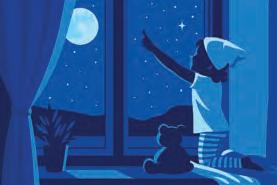
(b) Because the light from the Sun bounces off the moon.
B. Why does the Moon look different when seen on different days?
(a) Because the Moon changes its shape.
(b) Because we see different parts of the Moon’s bright side as it moves around the Earth.
C. When the Moon goes around the Earth, it means...
(a) the Moon is revolving.
(b) the Moon is hiding.
D. Does the Moon really change its shape?
(a) Yes, it grows bigger and smaller with time.
(b) No, it stays the same; we just see different parts of it.
New Moon Waxing Crescent First Quarter Waxing Gibbous Full Moon
Coloured sheet for activity on page 5
Coloured sheet for activity on page 9
Coloured sheet for activity on page 73
About the Book
STEM Exploration is thoughtfully designed to make learning a joyful journey of discovery through hands-on activities and real-world applications. Aligned with the NEP 2020 and the NCF 2022–23, it promotes experiential, multidisciplinary, and competency-based learning. By integrating Science, Technology, Engineering, Art and Mathematics (STEAM), it supports holistic development, builds essential 21st-century skills and empowers learners to contribute to a sustainable and equitable future in line with the UN Sustainable Development Goals (SDGs).
Key Features
• STEAM Alignment: Activities integrate Science, Technology, Engineering, Arts and Mathematics encouraging interdisciplinary connections
• Hands-on and Inquiry-Based Learning: Activities spark curiosity through exploration, observation and experimentation, helping learners develop scientific temper, creativity and problem-solving skills
• Digitally Powered: QR codes link to experiment videos for visual and self-paced learning
• Easy-to-Access Resources: Use of safe, low-cost and accessible materials with clear instructions for easy execution
• Real-World Connections: Activities and worksheets link concepts to daily life and local contexts ensuring meaningful and practical relevance
About Uolo
Uolo partners with K-12 schools to provide technology-enabled learning programs. We believe that pedagogy and technology must come together to deliver scalable learning experiences that generate measurable outcomes. Uolo is trusted by over 15,000+ schools across India, Southeast Asia and the Middle East.
ISBN 978-93-49697-69-0



